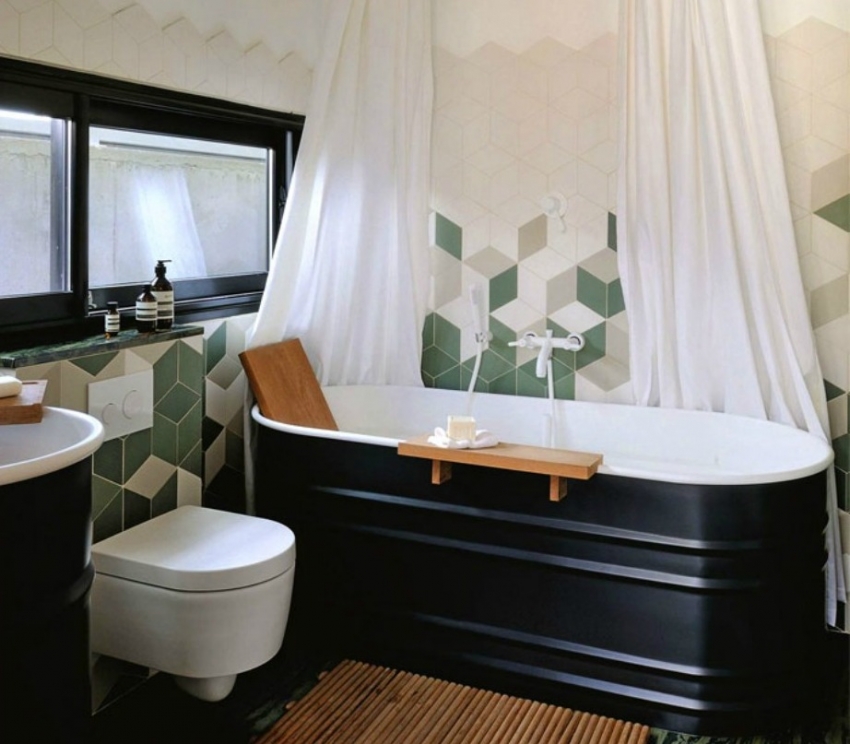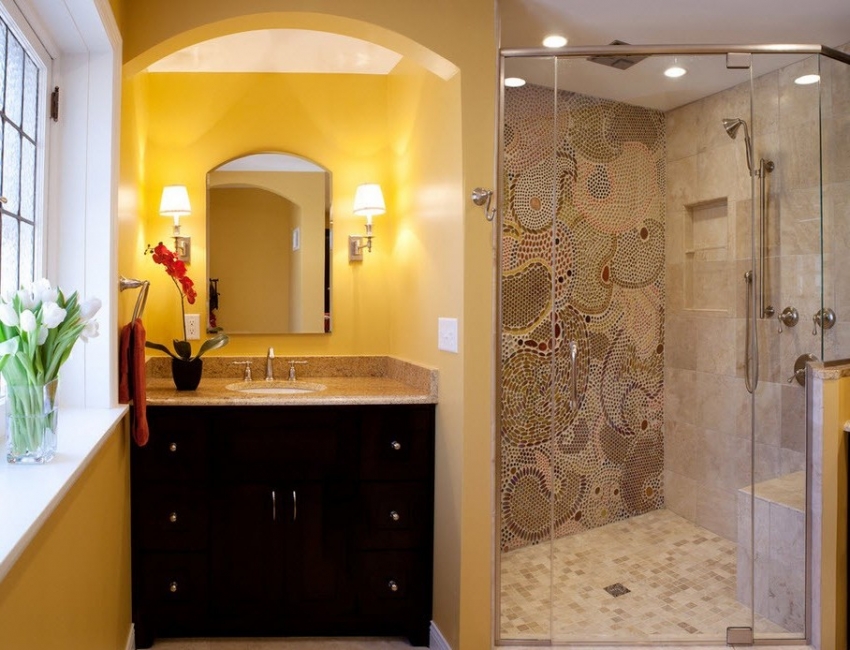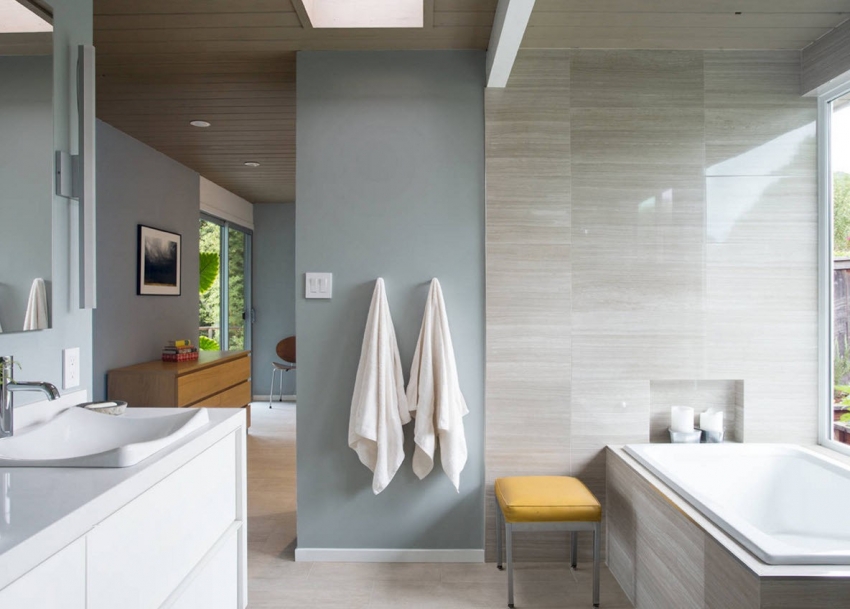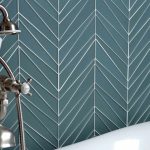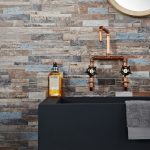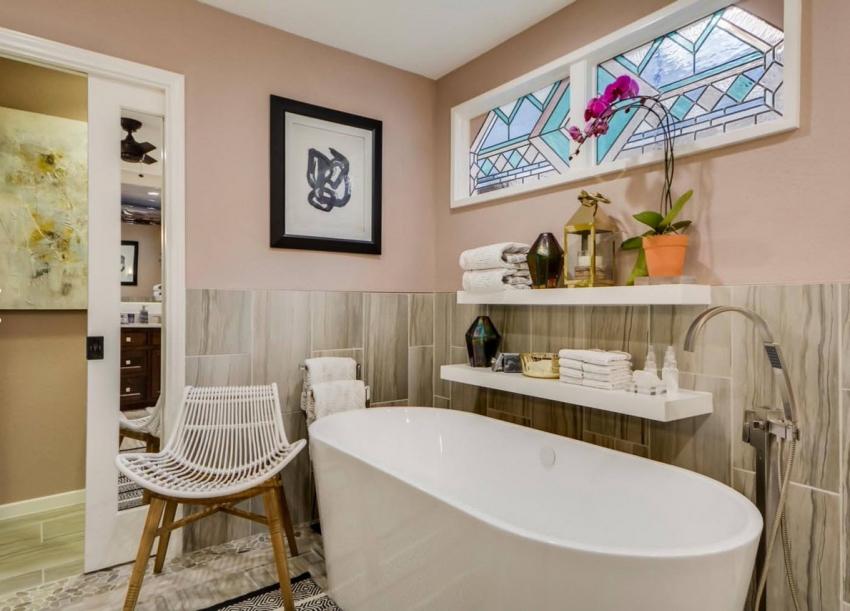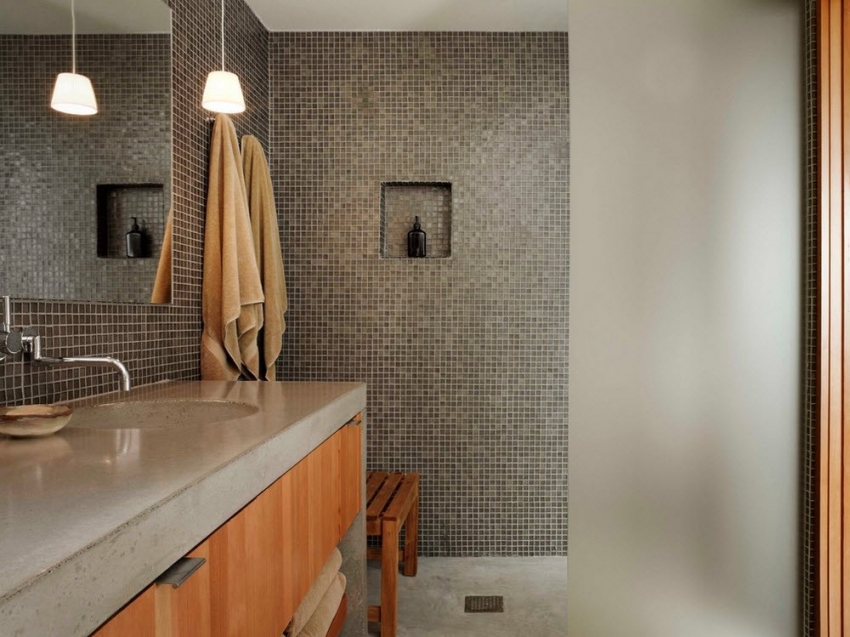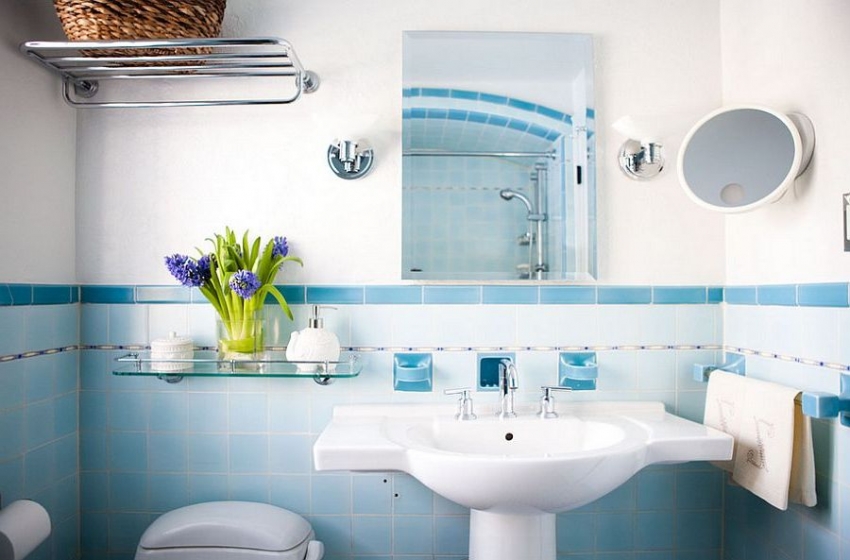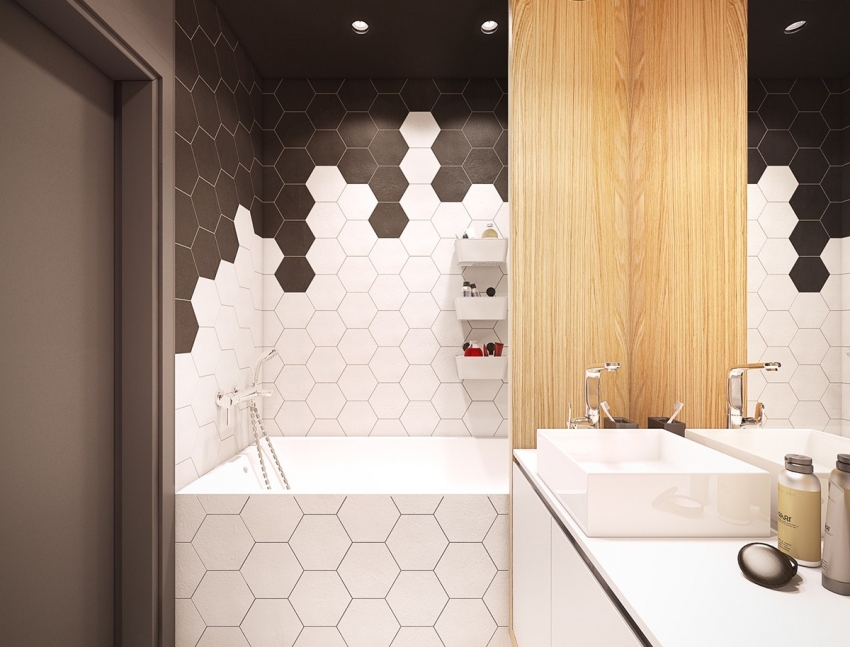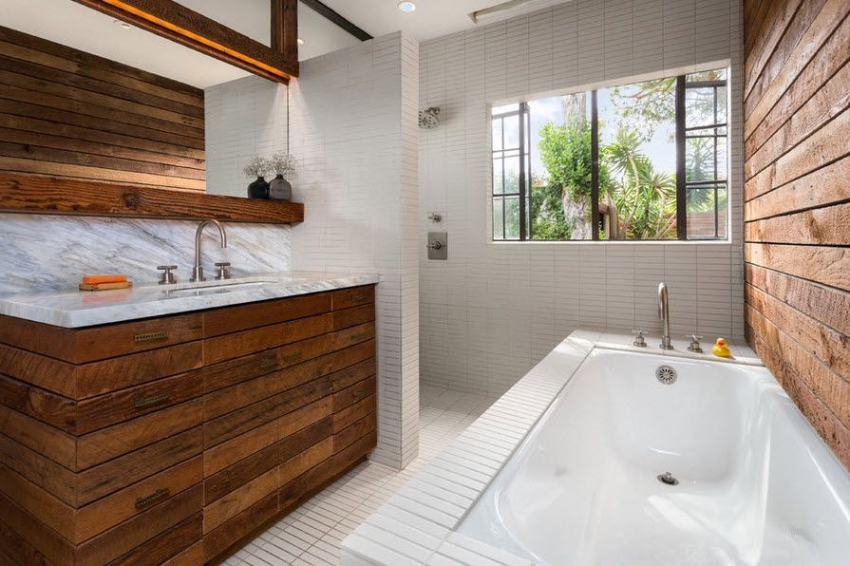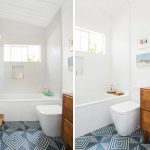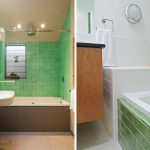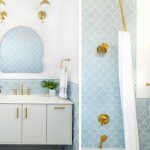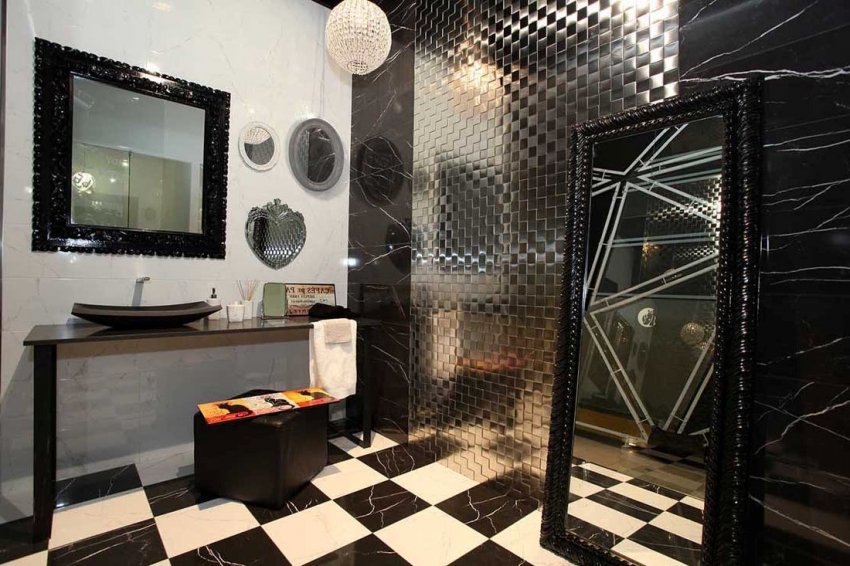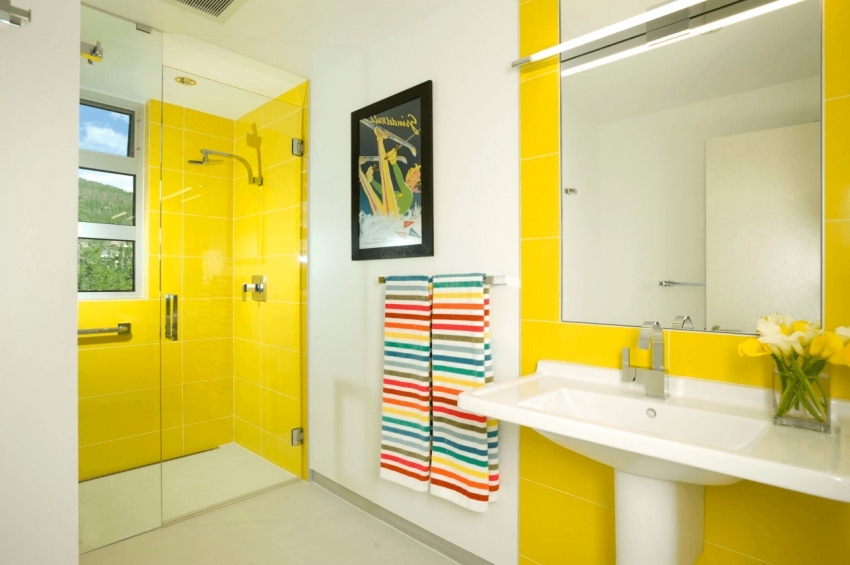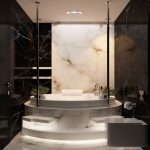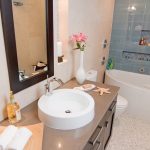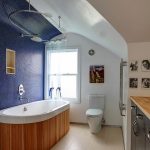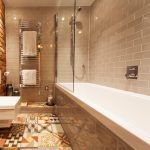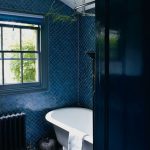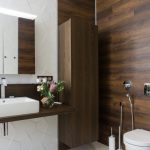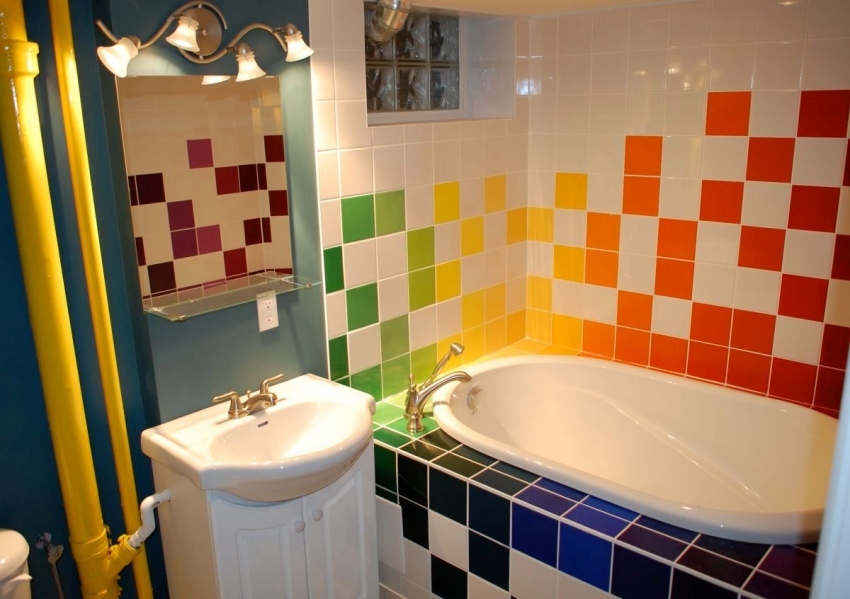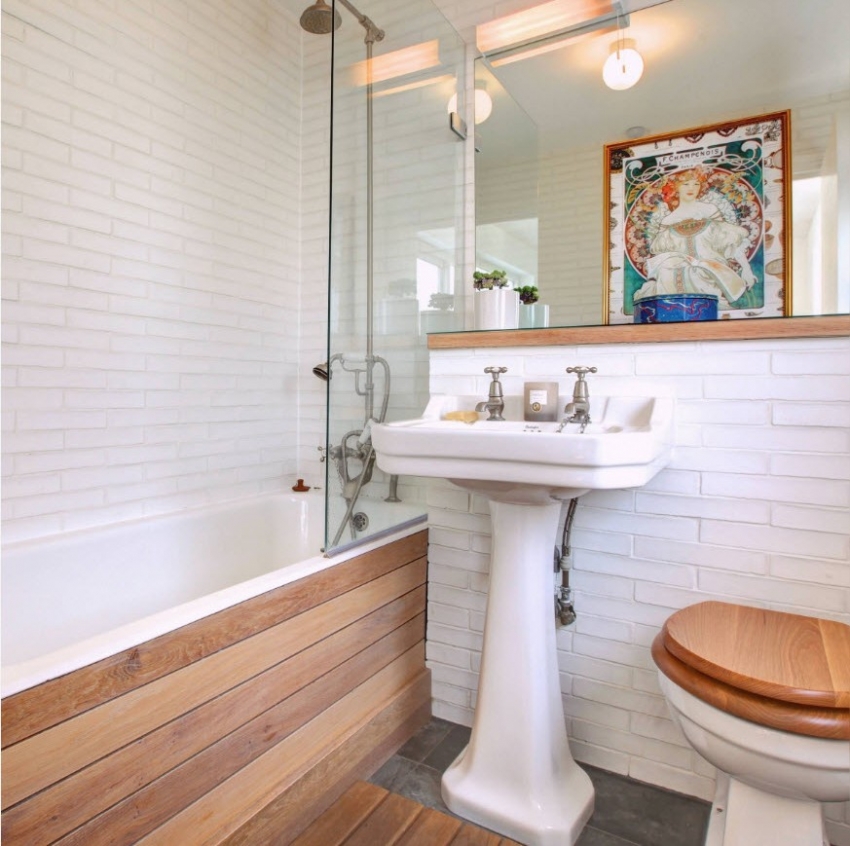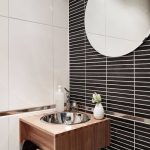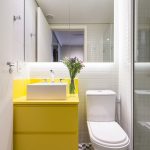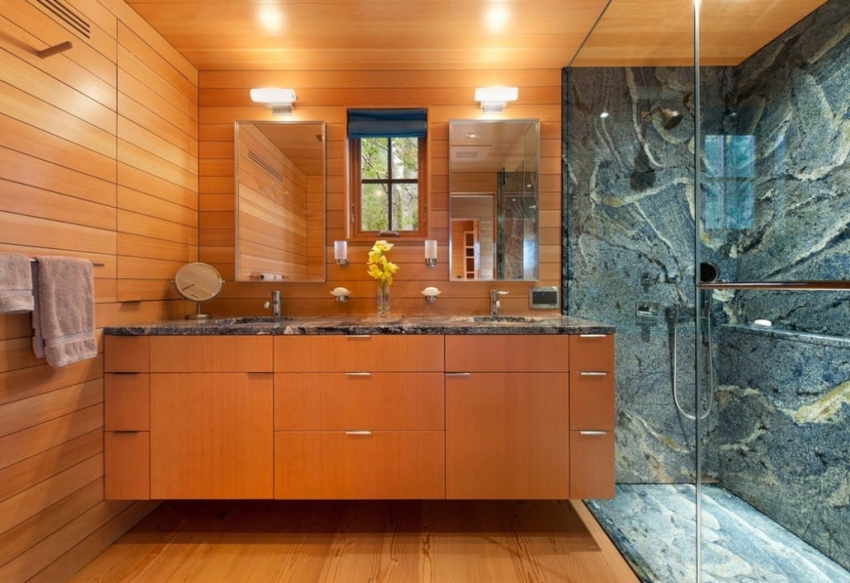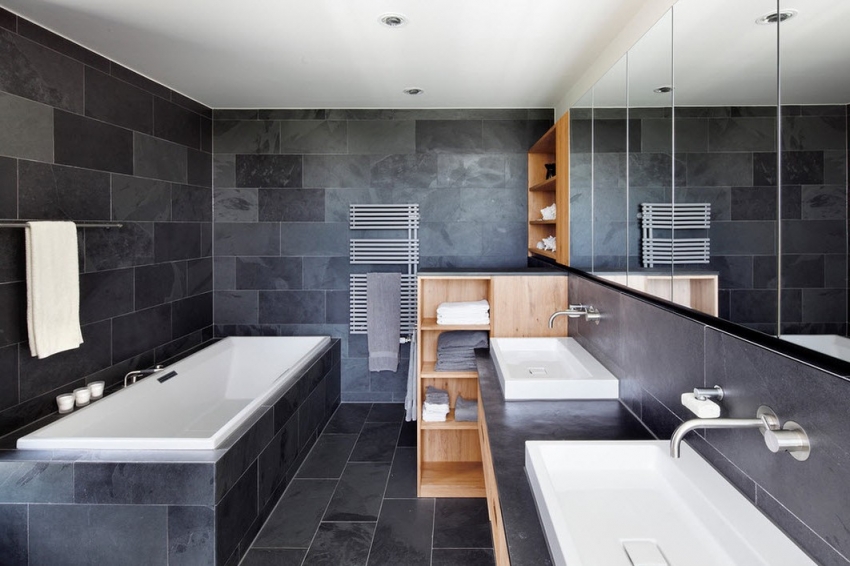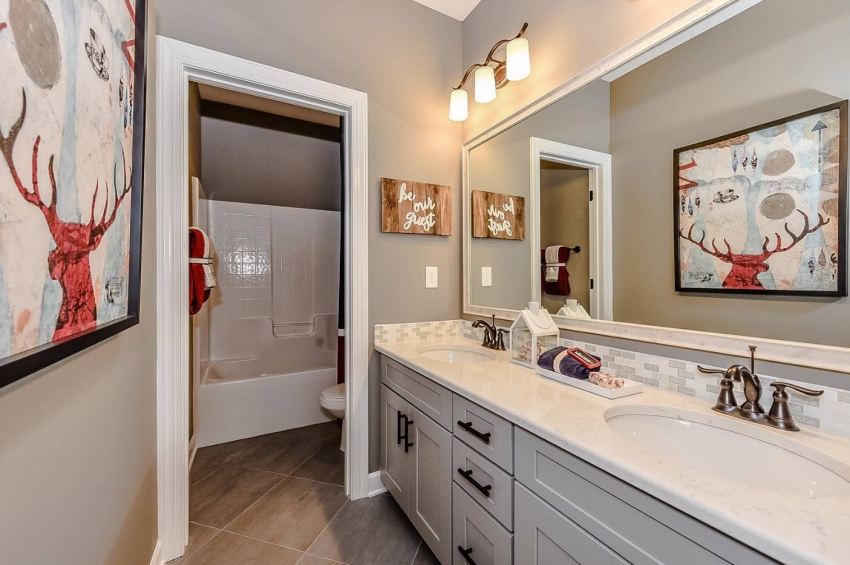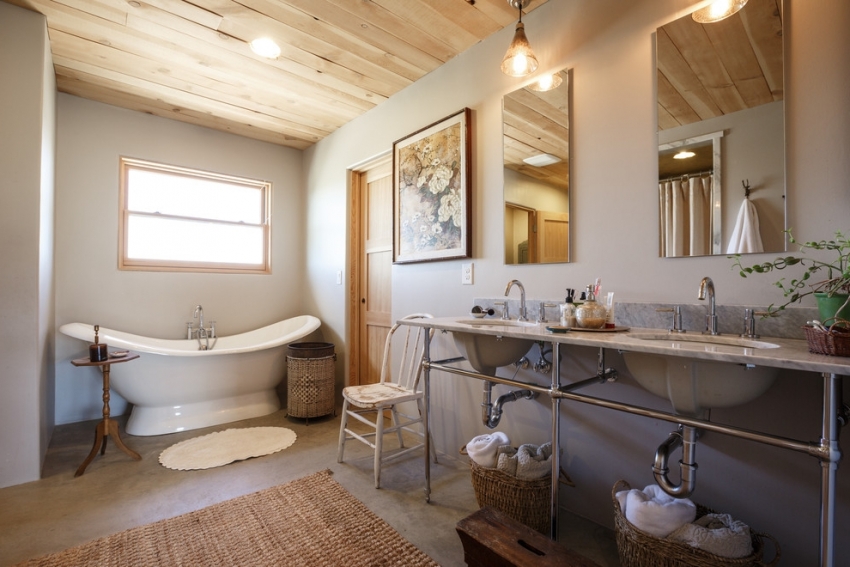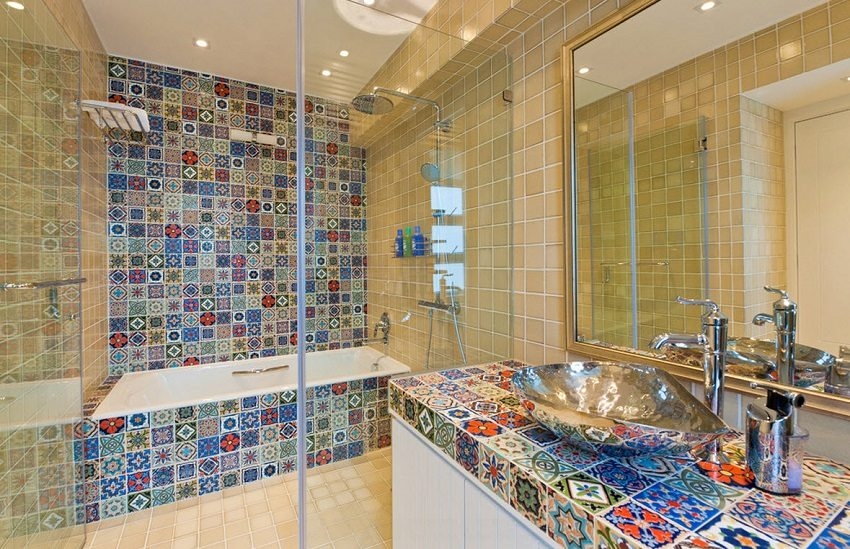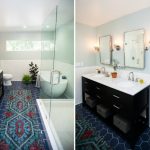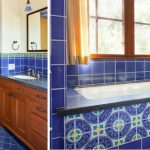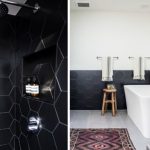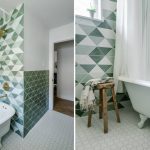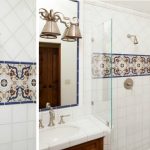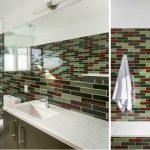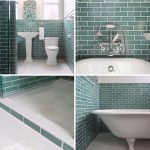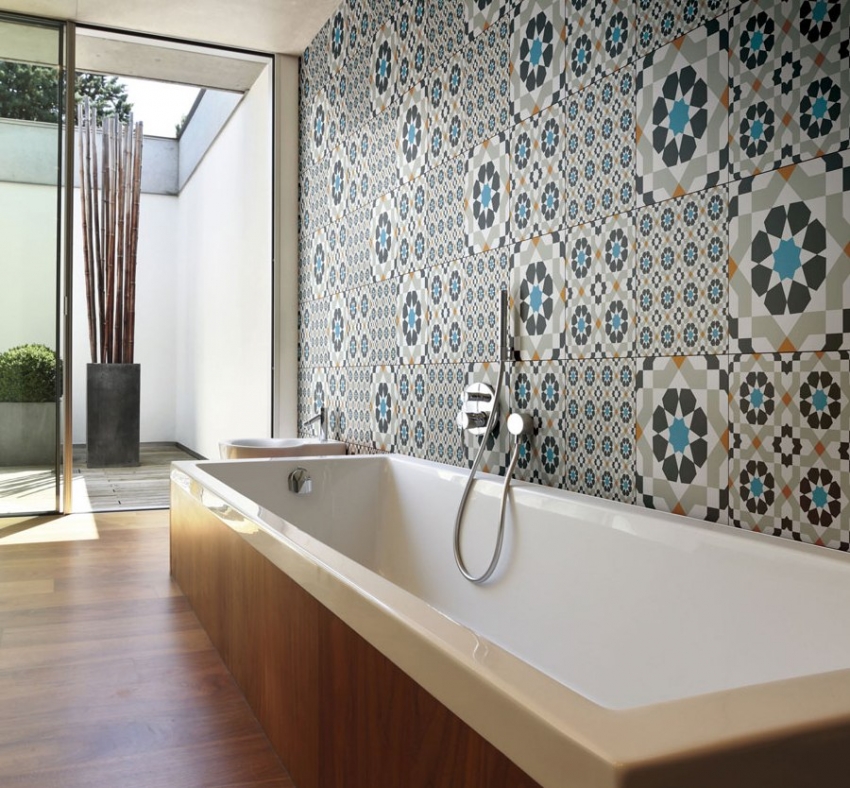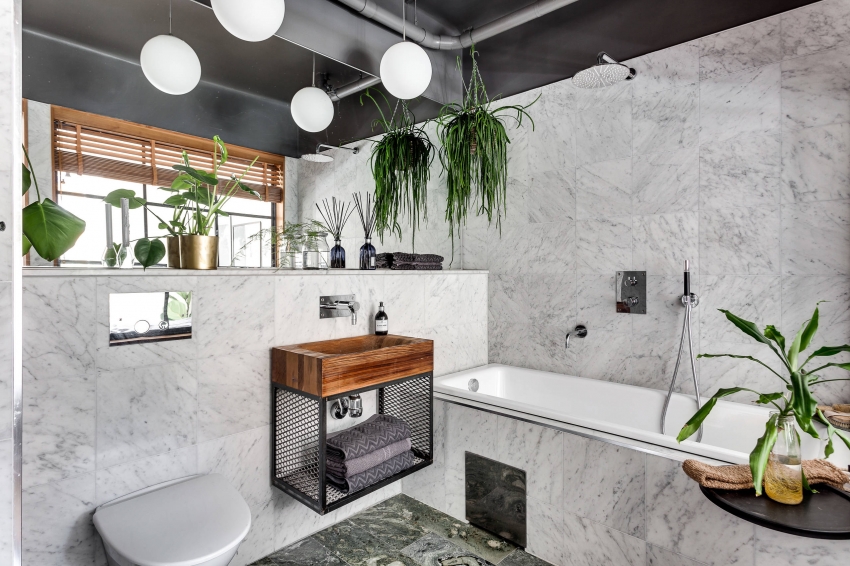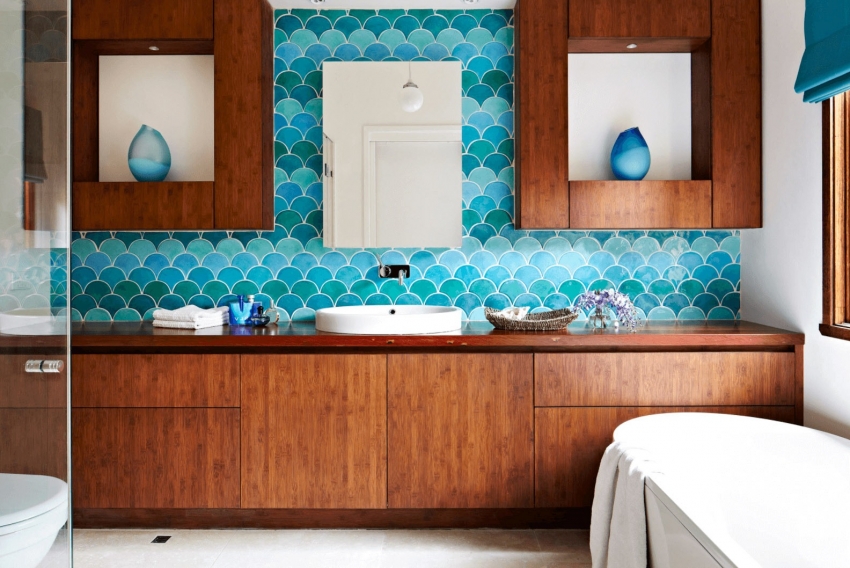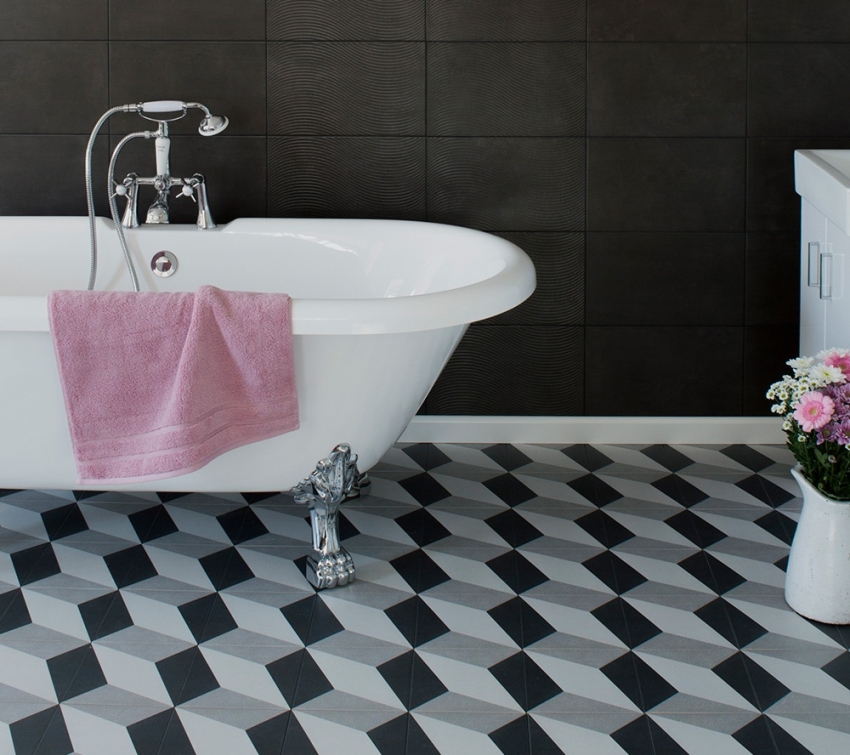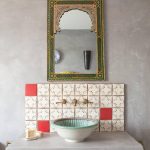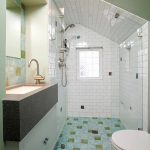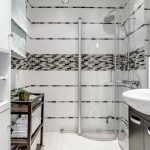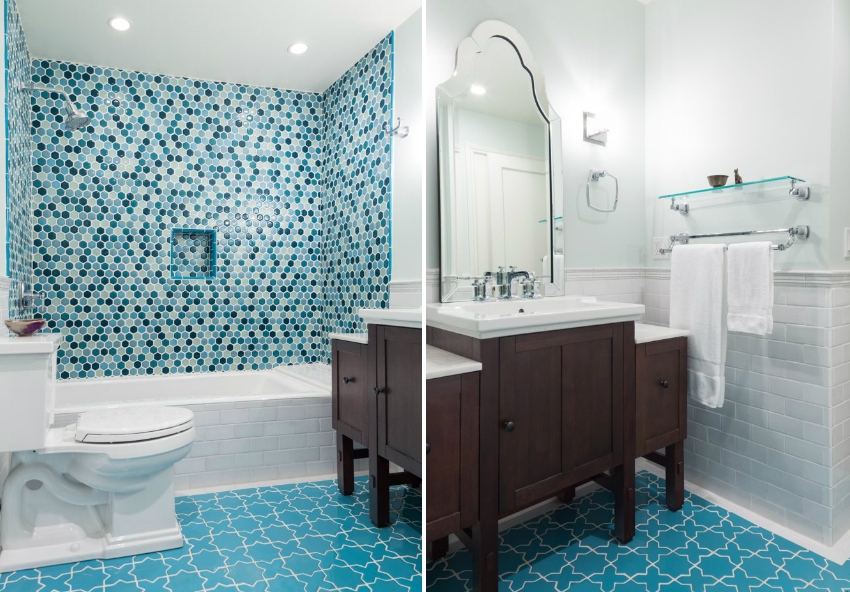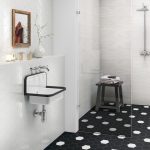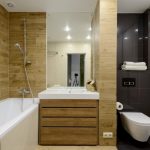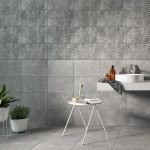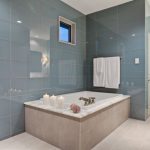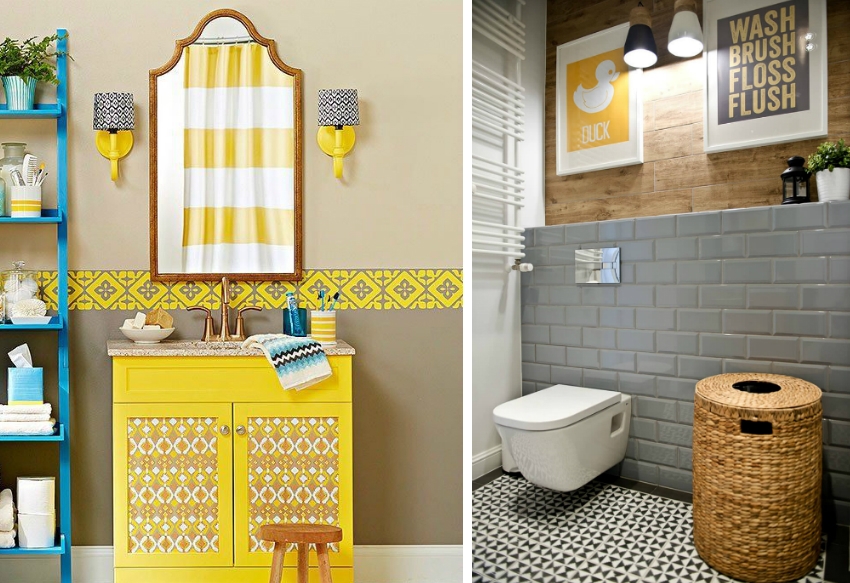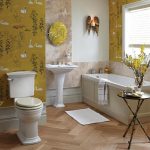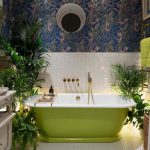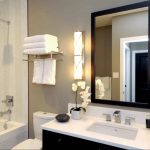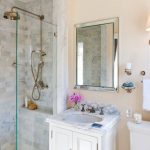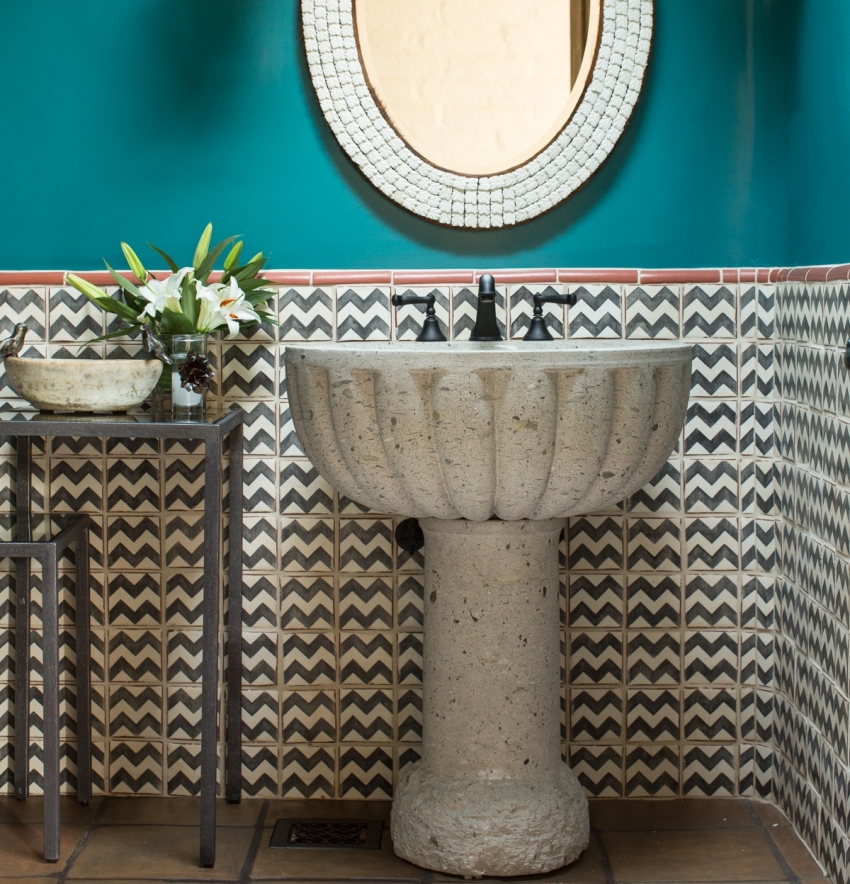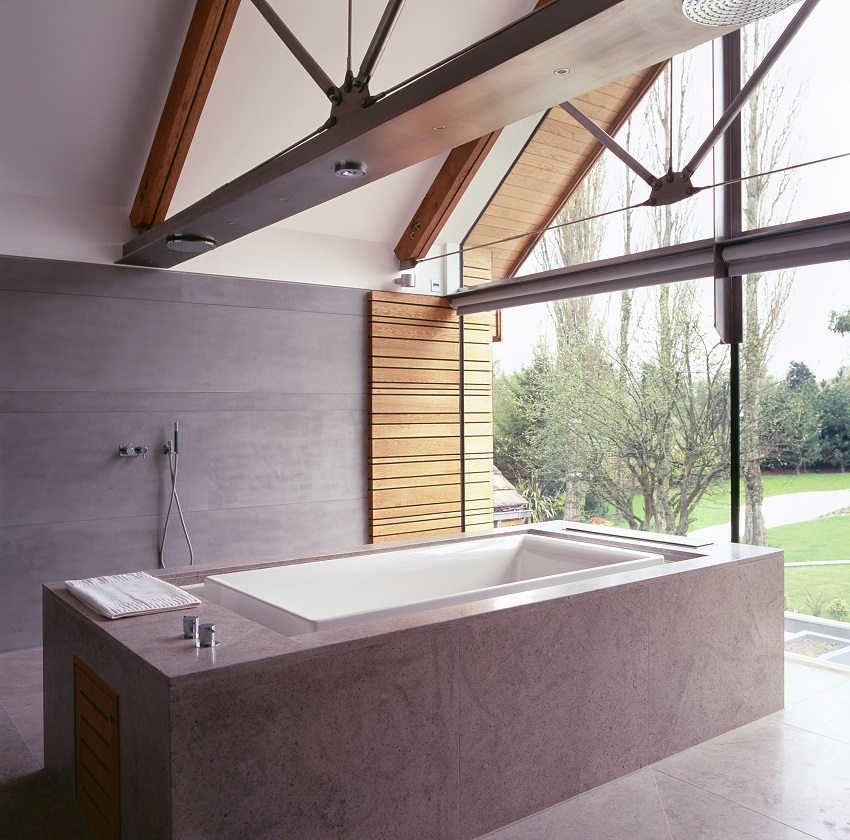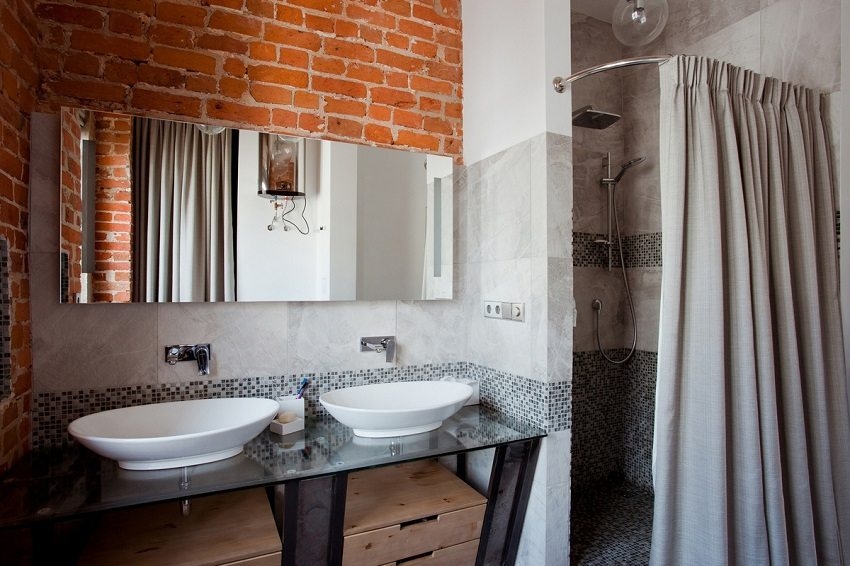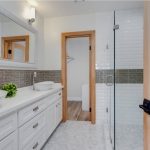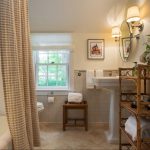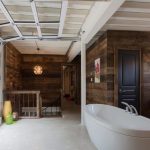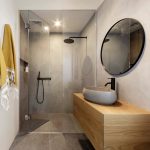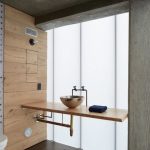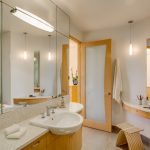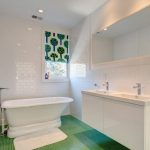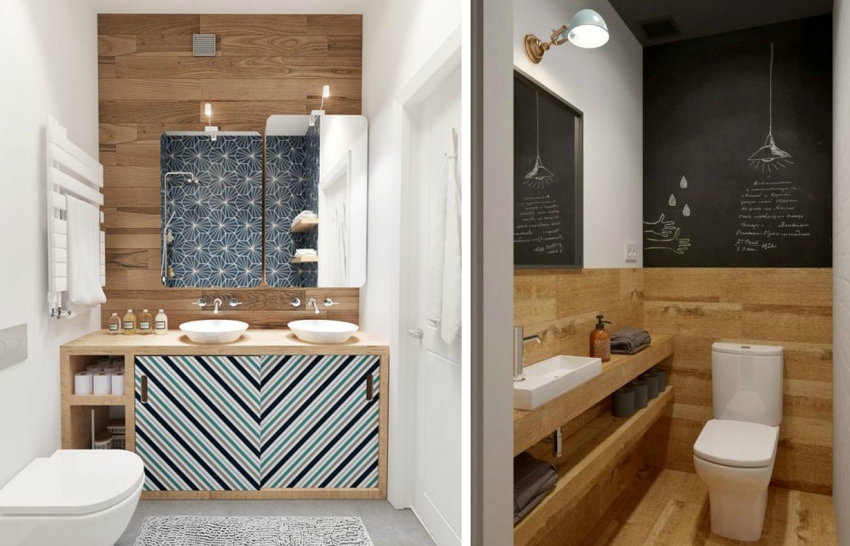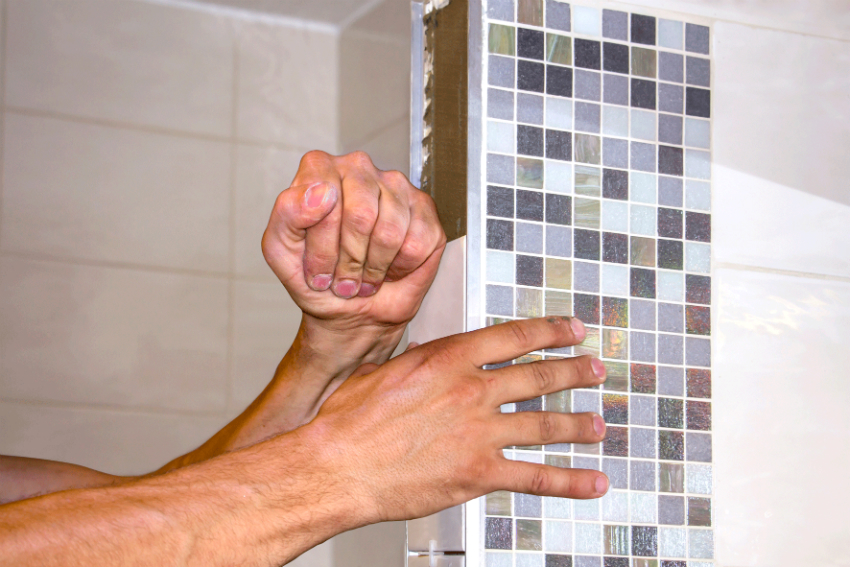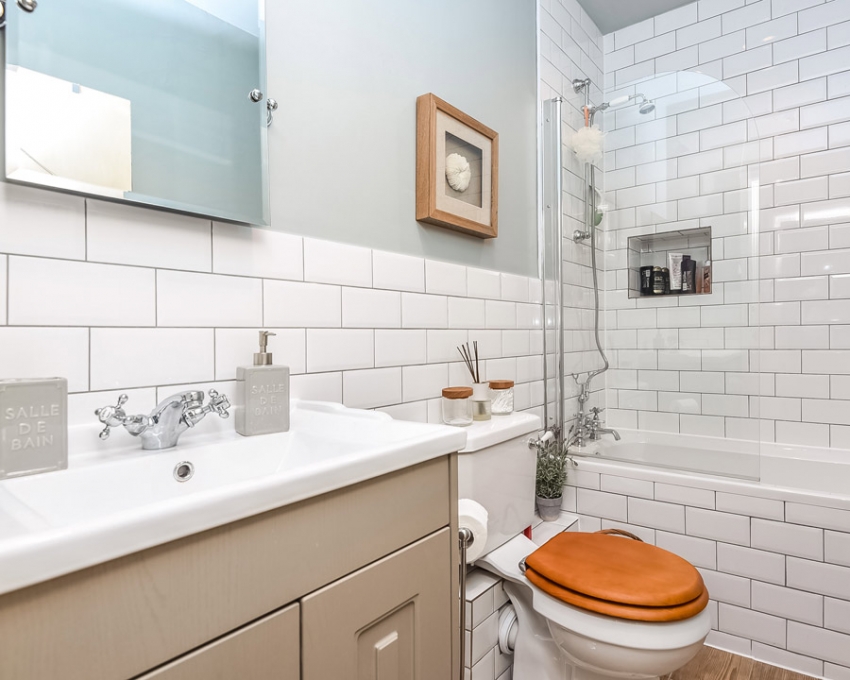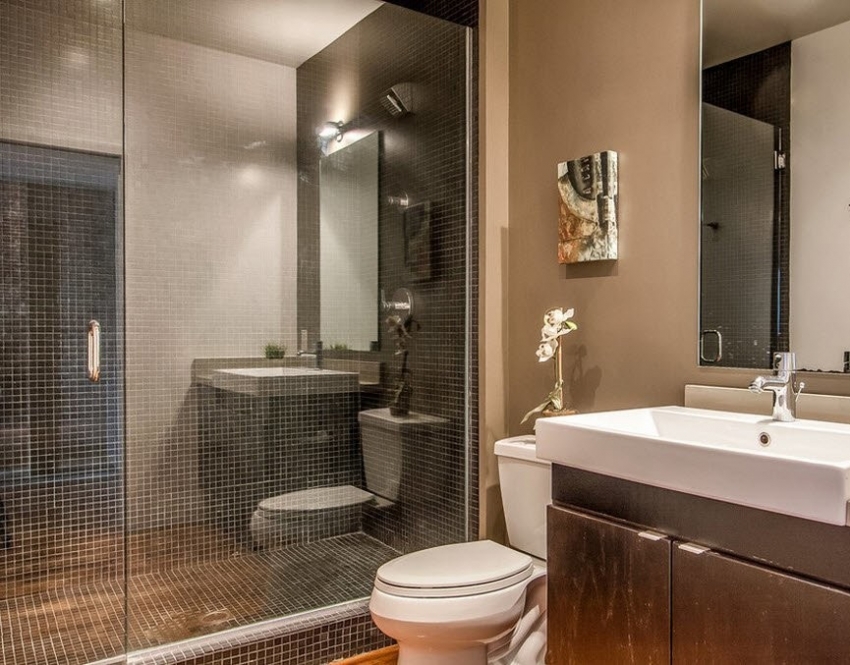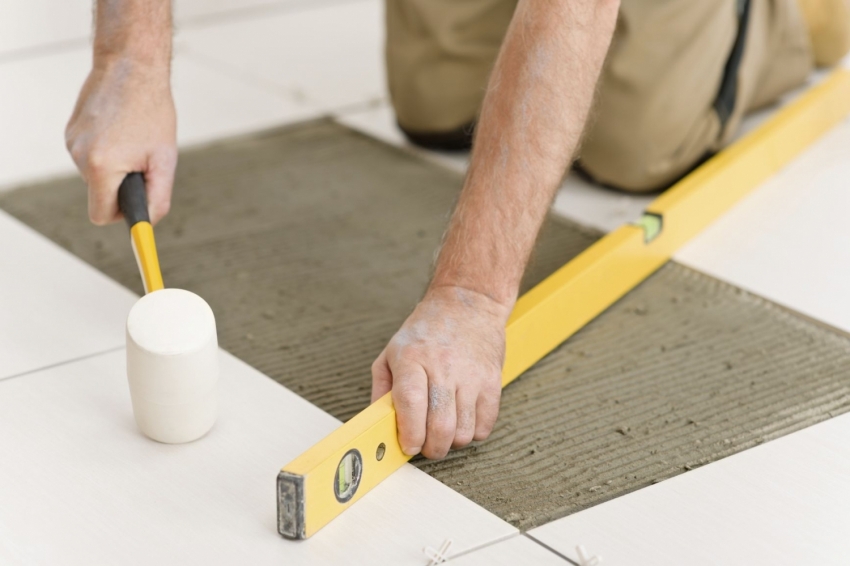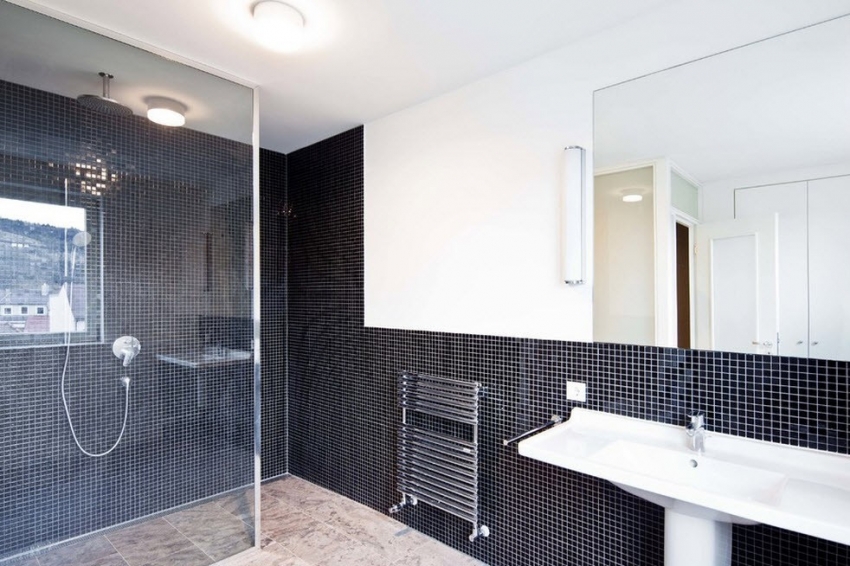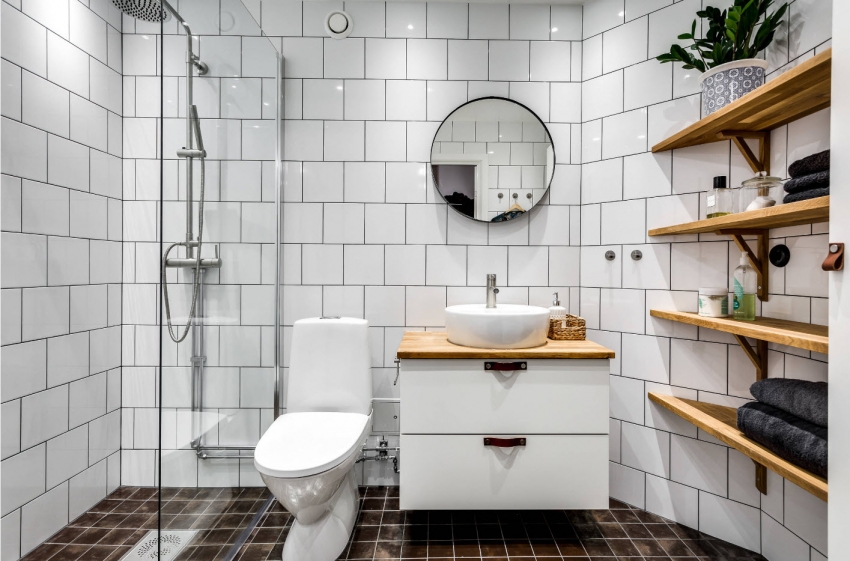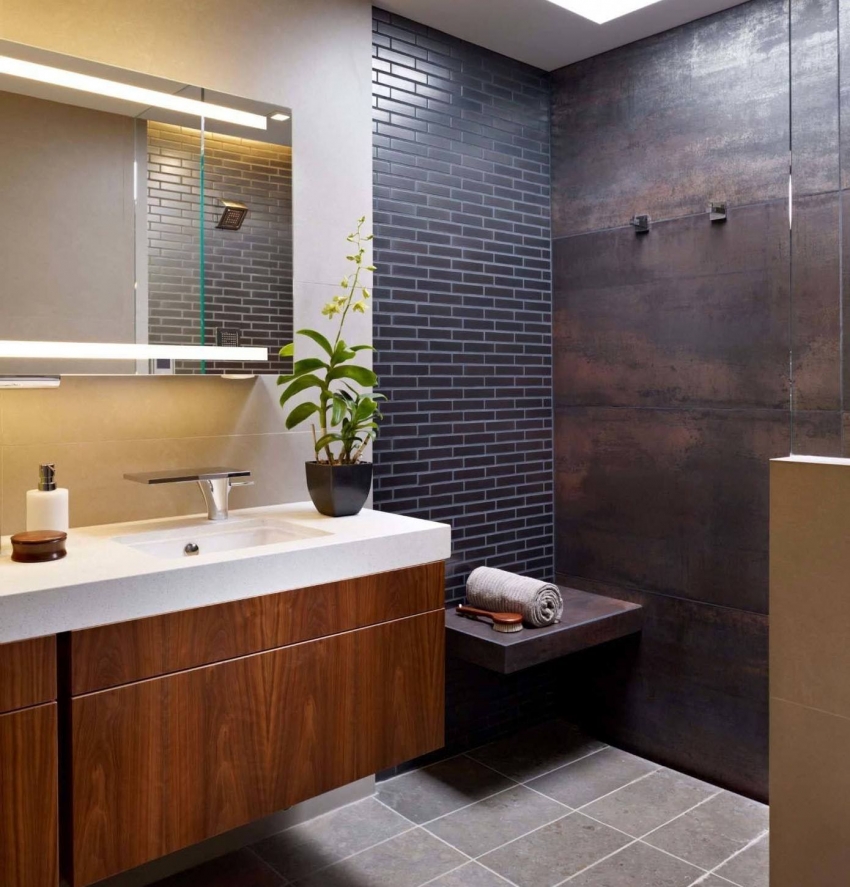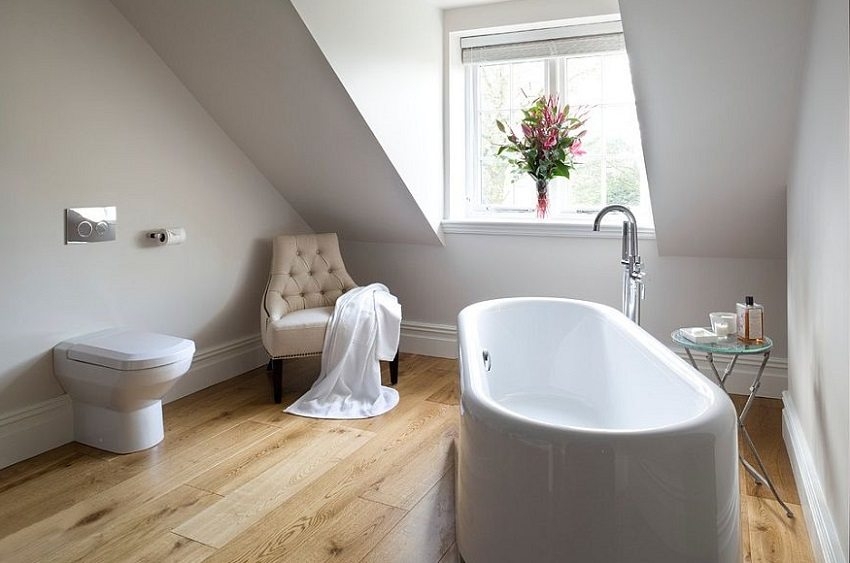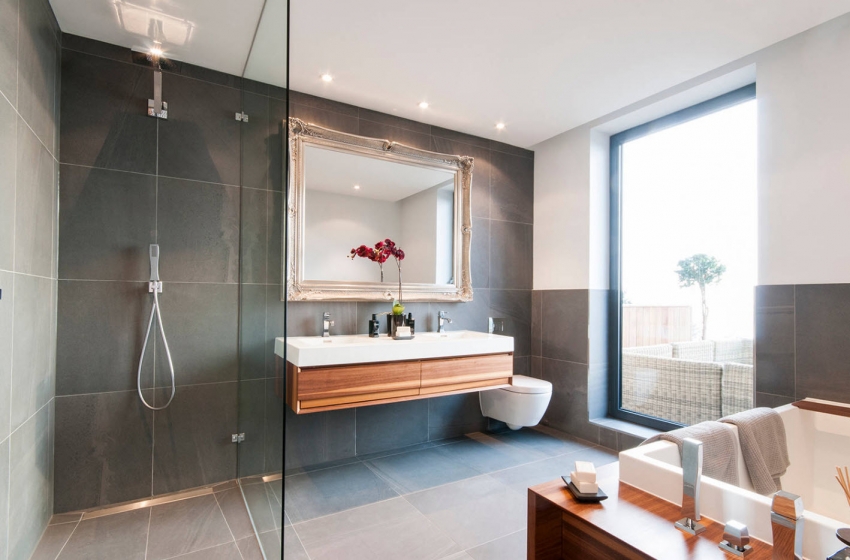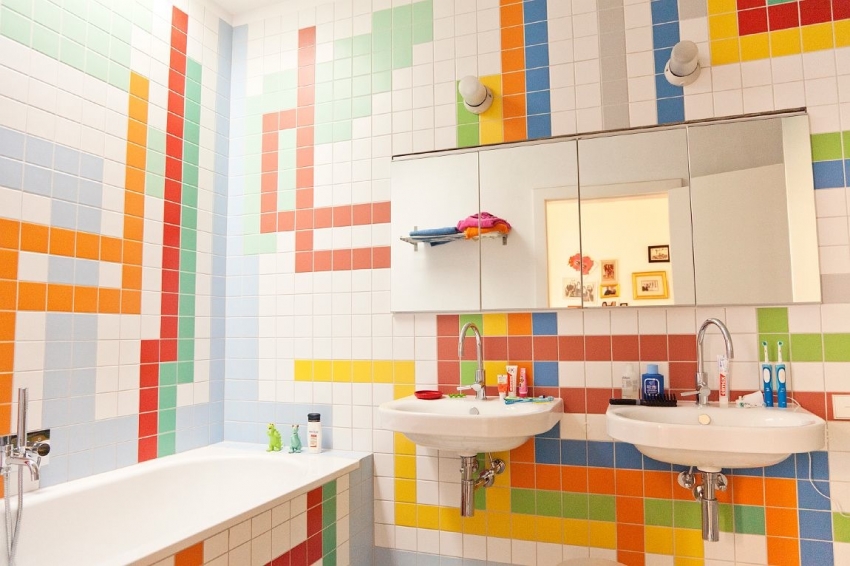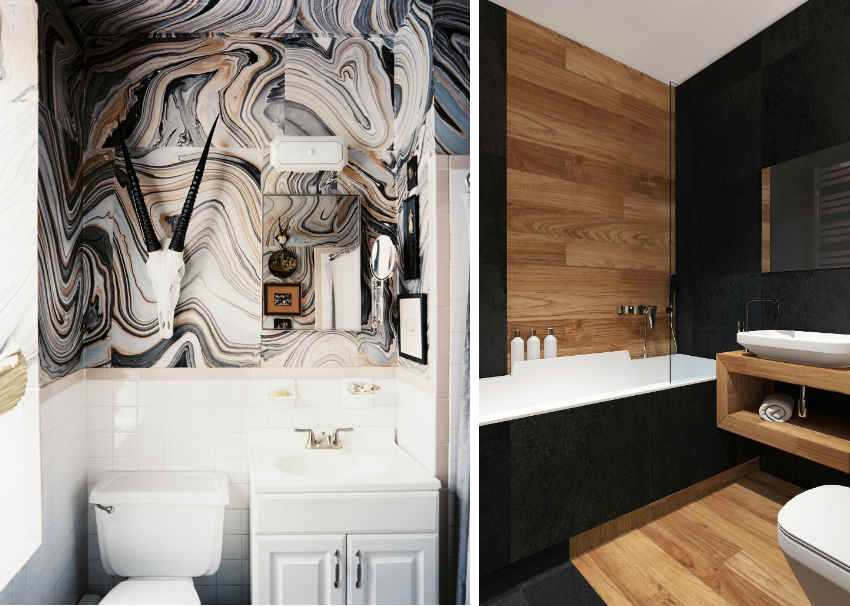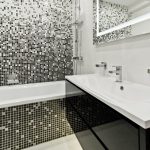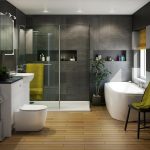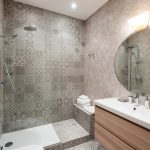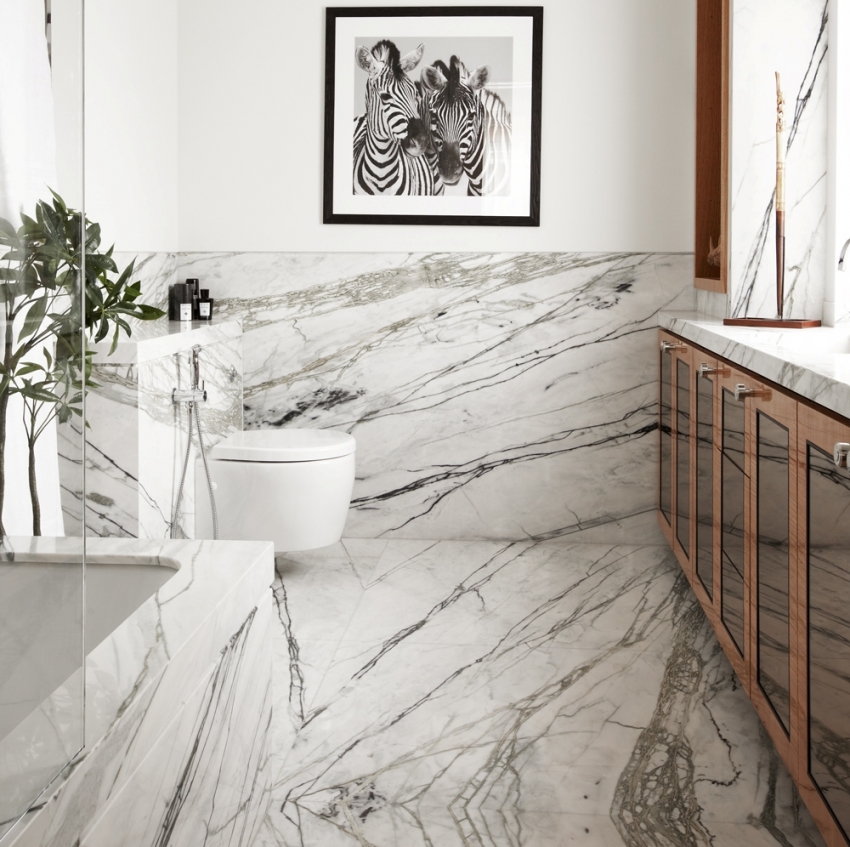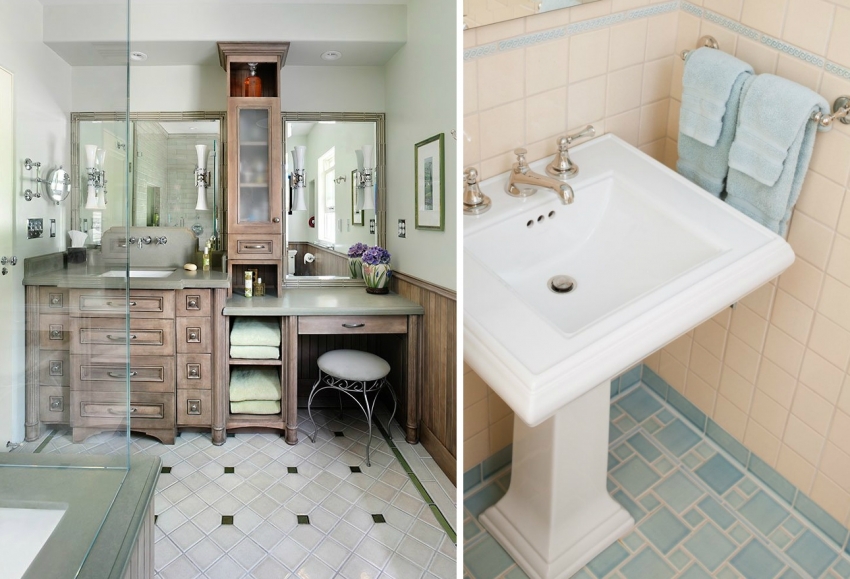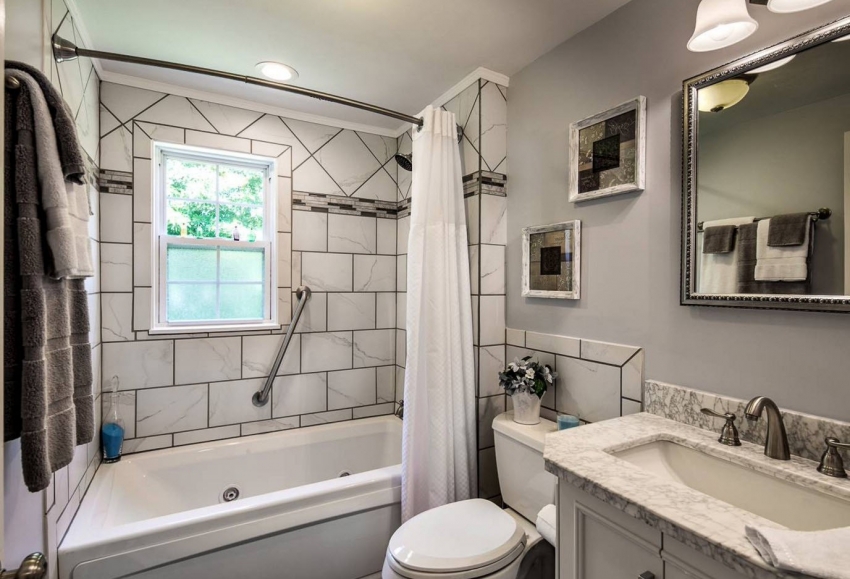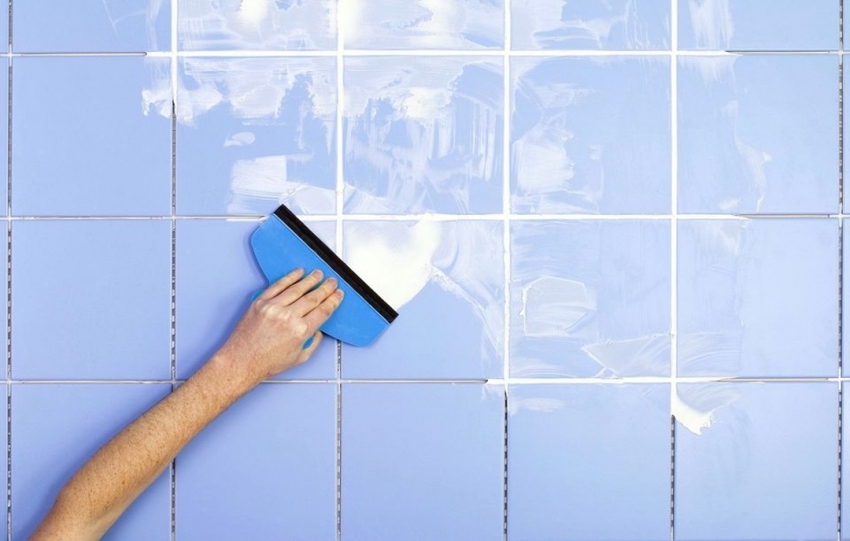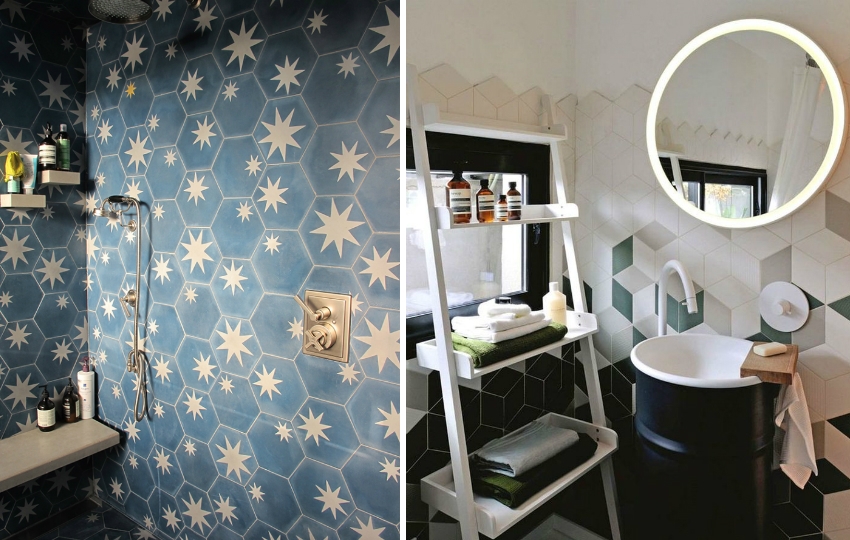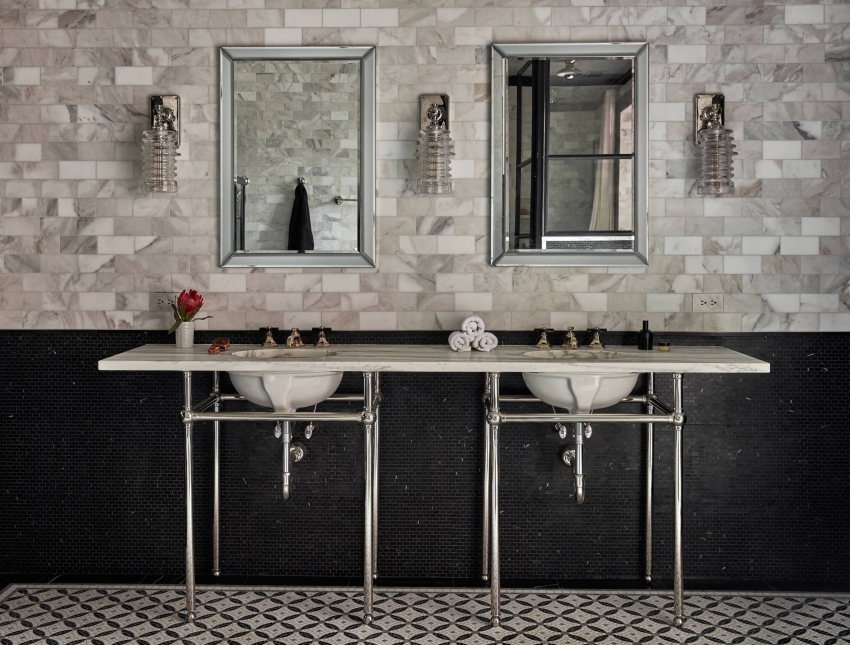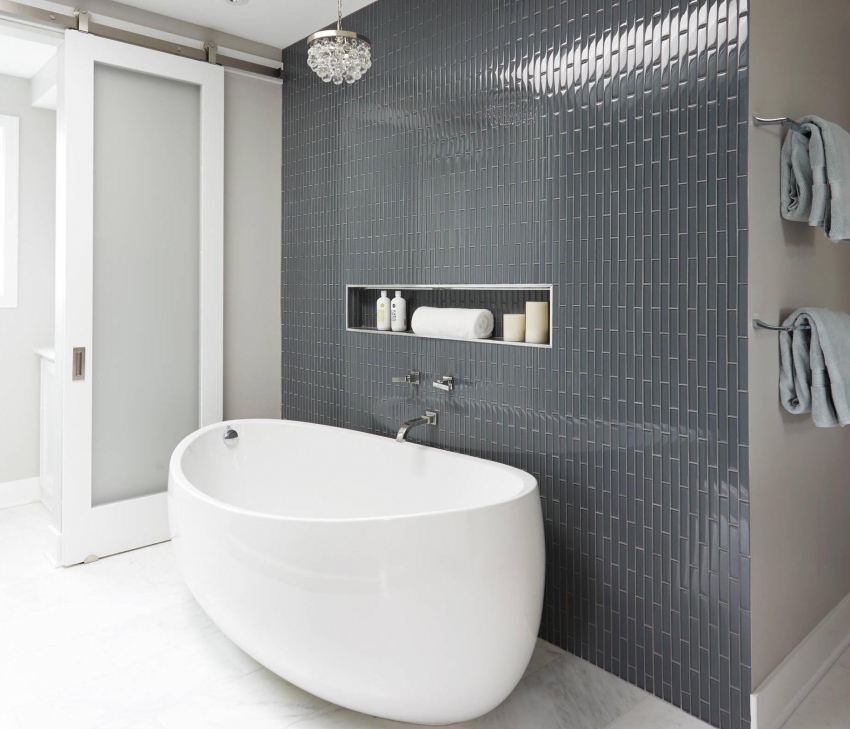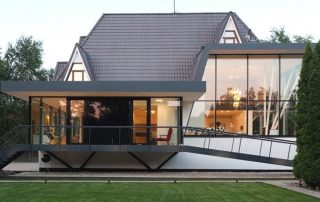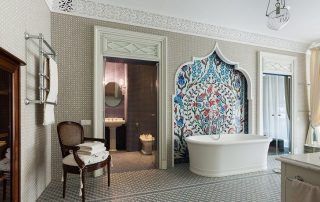The bathroom is one of the most important rooms in a living space, for which every owner strives to create a modern, beautiful and durable interior. Tile is considered the most popular material today, with which you can create many different variations for decorating a cozy and stylish room. This article will consider in detail the design of the bathroom: a photo of the decoration with tiles of successful interiors, as well as the features of laying the material on the floor and walls.
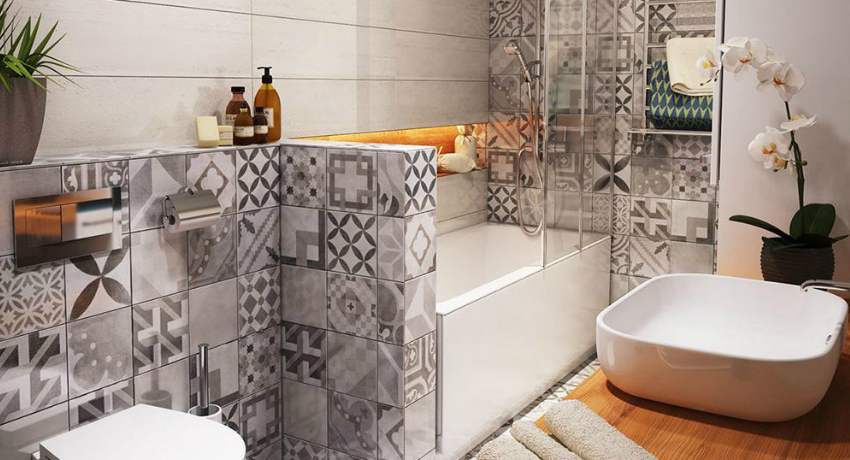
Decorating a bathroom with room tiles is one of the best solutions for creating a durable and stylish interior.
Content [Hide]
- 1 Material requirements for bathroom decoration
- 2 The main advantages and disadvantages of bathroom tiling
- 3 Varieties of tiles for the bathroom. Product photos
- 4 Choosing the color of the tiles in the bathroom. Room design
- 5 Size range of bathroom tiles
- 6 What is ceramic tiles in the bathroom?
- 7 Bathroom tiling options. Photo examples
- 8 Bathroom design: photo of tiling rooms made in different styles
- 9 Bathroom tile technology
- 10 Review of renowned bathroom tile manufacturers
Material requirements for bathroom decoration
The bathroom is a room with high air humidity. Therefore, the facing material must have increased moisture resistance and withstand dampness without loss of performance and original appearance.
Tile for the bathroom today is the most popular option for interior decoration, thanks to which you can create a beautiful, stylish, practical and durable design.
When choosing a tile for the bathroom, you should be guided by the following recommendations:
- the material should have a low level of porosity, due to which poor moisture absorption is ensured;
- the tile must withstand temperature fluctuations without compromising the integrity of the surface and deteriorating its appearance;
- the front surface must be of high quality, on which the color and clarity of the pattern will remain for a long time;
- the product must withstand the effects of chemical and aggressive detergents;
- wall tiles must be at least 6 mm thick, and for the floor - 9 mm;
- bathroom floor tiles should be of the second or third class of wear resistance and have a non-slip surface.
Among the wide assortment of tiles on the construction market, you should give preference to high quality products that meet the above requirements. When buying material, you must carefully examine the appearance of the products. The edges of the tiles must be even, without dents or chips. The product must have a strict geometric shape. The face of each tile from the same batch must have a clear, uniform pattern.
The main advantages and disadvantages of bathroom tiling
Today, many by inertia choose tiles as a finishing material for the bathroom. And this is not surprising, because this material has a number of advantages that bring it to a leading position among other products that can be used to decorate rooms with high humidity.
Consider the strengths of using tile for bathrooms:
- the maximum degree of moisture resistance of the material allows you to reliably protect the walls and floor in the bathroom from moisture;
- high resistance to the formation of fungus and mold on the surface of the tile;
- the material has increased strength, especially for porcelain stoneware and ceramic tiles;
- durability of the finishing surface;
- the tile is easy to use and undemanding to maintain;
- products are able to maintain their original appearance for a long time under constant exposure to moisture and chemicals;
- when laying tiles, there is no need to install an additional frame;
- a wide range of tiles in the bathroom, photos clearly confirm this, allows you to decorate a room of any size and shape, in a different stylistic direction.
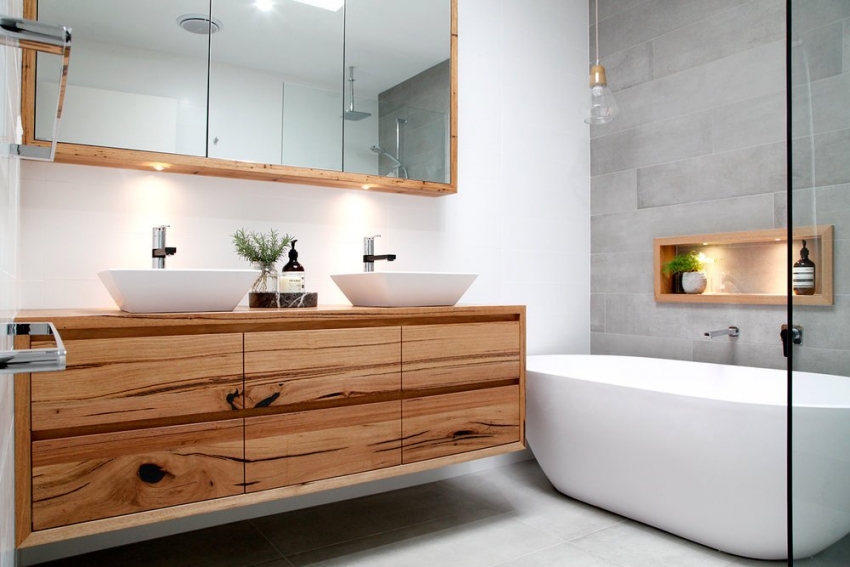
Modern antiseptic solutions and protective varnishes allow the use of natural materials even in areas of high humidity
Negative sides of the material:
- high cost of products;
- laborious and expensive tile installation;
- when laying tiles, seams are formed, on the surface of which, subsequently, without proper care, bacteria can multiply and a fungus can form, which will not only worsen the appearance of the cladding, but will also negatively affect the health of the owners of the room.
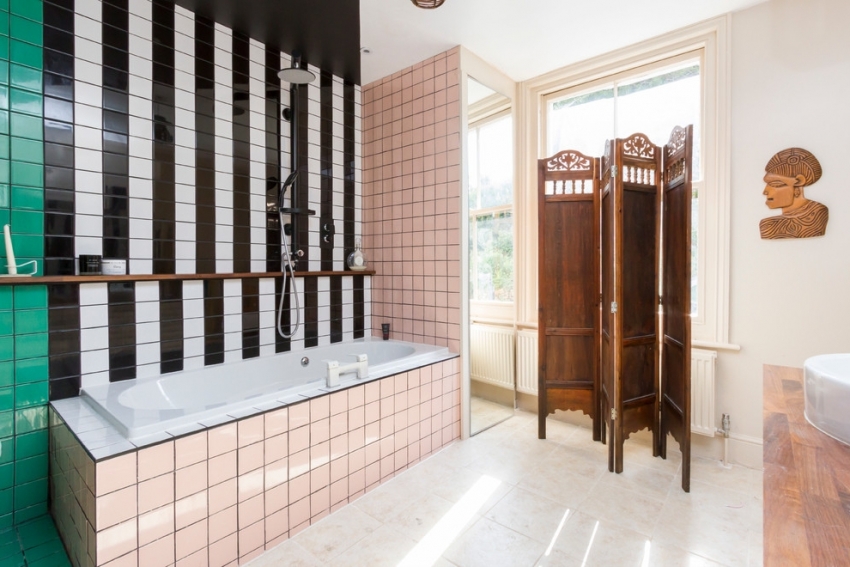
With bright inserts from ceramic bathroom tiles you can zone the space of the room
Varieties of tiles for the bathroom. Product photos
Depending on the purpose, all tiles that are used to decorate bathrooms are divided into three main types:
- wall;
- outdoor;
- decor.
Bathroom wall tiles have a softer structure. Thanks to this property, the material is easy to cut, creating even edges without chips. This is very convenient when adjusting the tile to a certain size or when cutting holes in it for various communications.

The complex pattern of laying ceramic tiles on the walls of the bathroom requires accurate markings and working skills
Tiles with a high level of moisture resistance are used here. The surface of the product can have a smooth or embossed structure.
Bathtub floor tiles have a denser structure. As a rule, these are square-section products with increased wear resistance. The tiles must have a non-slip base, therefore, glazed products are not recommended here.
Useful advice! To create a harmonious bathroom design, choose floor and wall tiles from the same collection.
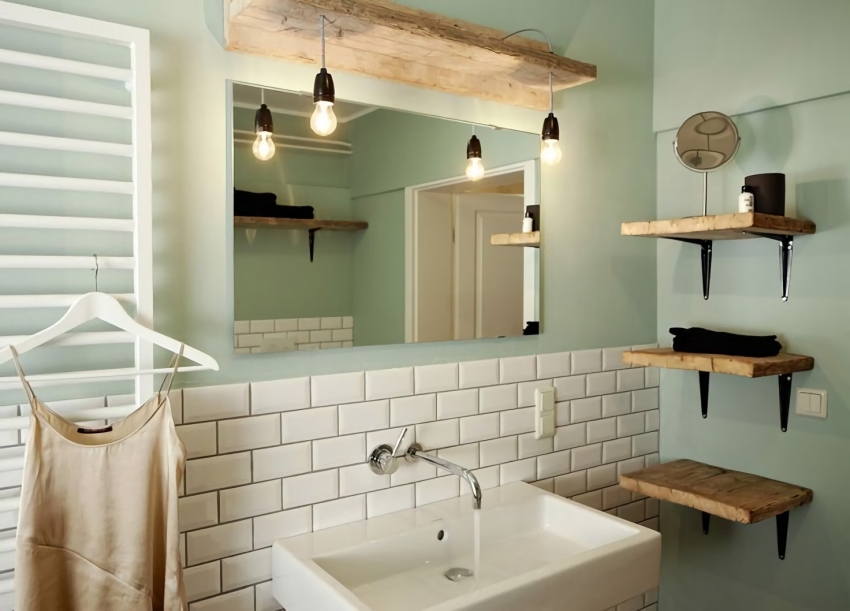
In modern design, a popular technique is to combine ceramic tiles and simple wall painting with waterproof paint.
The decor is represented by narrow inserts with a variety of ornaments, which can dilute the boring tiled canvas and make the room unique and inimitable. This group of tiles, the photos clearly demonstrate various options, include a piano, a freesize piano, a decorative border, mosaic and other types of friezes.
Types of bathroom tiles, depending on the material of manufacture
Among the facing materials, ceramic tiles remain the most popular today, photos of bathrooms clearly confirm this. Due to the special manufacturing technology, the material has increased strength and performance characteristics. Products are presented in a wide range of colors and textures, which allows you to create a unique, aesthetic room design.
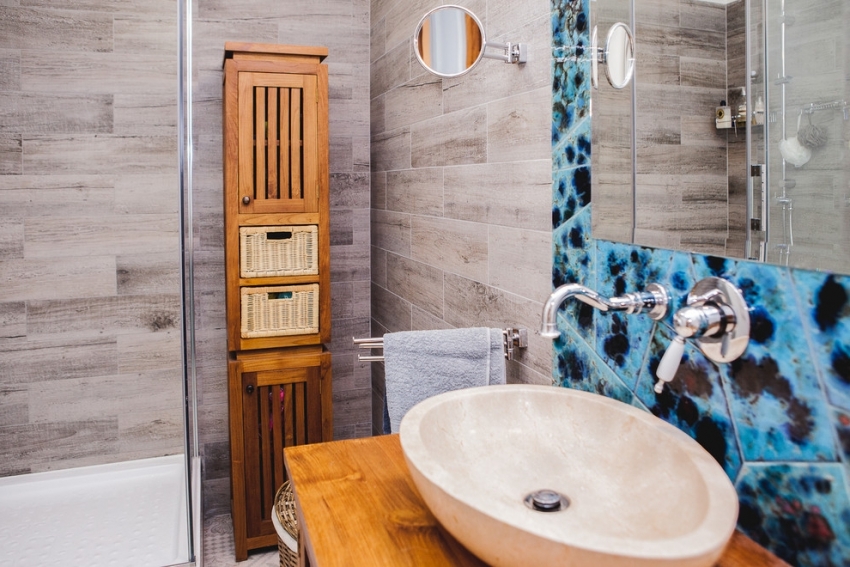
Modern manufacturers offer a wide selection of ceramic tiles with the immigration of natural materials
Mosaic tiles are an elite type of product. It is presented in the form of small squares of a glass or ceramic base, laid in a certain order on a mesh that is attached to the surface.
Related article:
Bathroom tiles: design, photos and recommendations for choosing
Photos of interesting room ideas. Advantages and disadvantages of using tiles for bathroom decoration. Tile laying recommendations.
One of the most attractive types of material is glass bathroom tiles. Photos of the interior design of the premises using this material look voluminous and airy. This is ideal for small bathrooms. However, this is one of the most expensive materials, which also has a fragile structure.
Useful advice! Glass tiles can be used as a decoration for the main tiled wall covering.
The most expensive is the porcelain tile for the bathroom. The tile has a dense structure that is ideal for flooring. The surface of the material is polished. This allows you to create a beautiful appearance of the product.
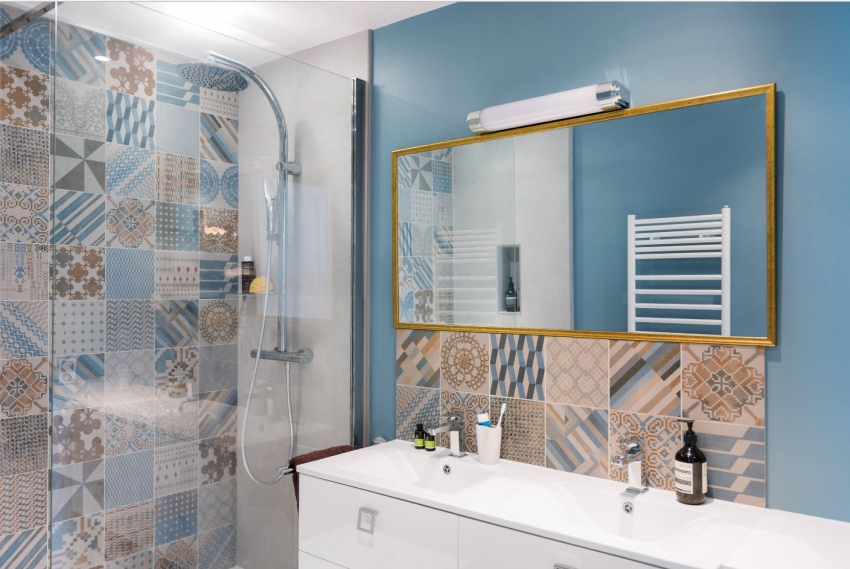
Using the online service, you can accurately calculate the number of tiles required, depending on the combinations and layout of the pattern
Bathroom tiles made of artificial stone have high strength characteristics. It does not wear out, withstands high indoor humidity and significant temperature changes. Stone tiles are usually produced in a unique design, which allows an unusual and aesthetic decoration of the room.
Assortment of ceramic tiles in the bathroom
Ceramic tiles in the bathroom can be made using various technologies, thanks to which they acquire their unique properties. Depending on this, several types of material are distinguished:
- clinker tiles;
- mosaic;
- majolica;
- cottoforte;
- faience;
- bicottura;
- monocourt;
- tuscan;
- porcelain stoneware.
Clinker tiles can be extruded or extruded. Each product has clear geometric dimensions and a flat surface. The extruded material has increased strength, density and wear resistance. It is the ideal flooring solution. The pressed type of product is more often used for wall cladding. However, this is a very expensive material.
Useful advice! By using wood-like tiles for the bathroom, you can create an imitation of a sauna or bath made of wood in the room.
Mosaic ceramic tiles, photos clearly display various variations of the product, represented by small tesserae, which are glued to the base in a certain order. It is a tough, durable material that comes in rolls. With its help, you can create an unusual and unique room design.
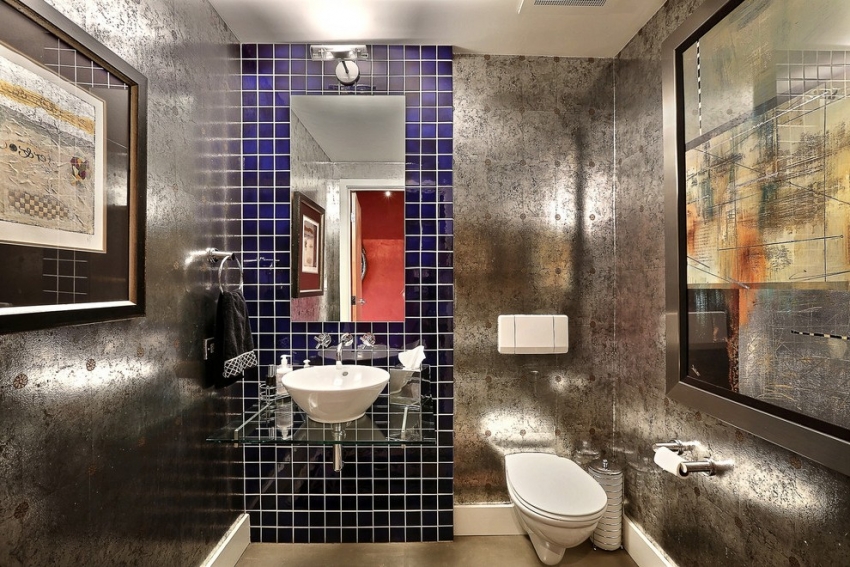
Tiles with an unusual texture or imitation may not be found in a regular store, but you can solve the issue of such a purchase by looking at the online catalogs of manufacturers
Metlakh tiles, or majolica, are from Italy. It is made by double firing of quarry clay. The result is a durable material with an opaque glazed surface depicting colorful ornamentation. This patterned ceramic tile is used exclusively as a wall covering.
Beautiful photos of cottoforte ceramic tiles confirm its unsurpassed and unusual design. The surface of the tiles is covered with an opaque glaze. It is a versatile product that can be used for both flooring and wall cladding.
Faience ─ ceramic tiles for bathrooms with a pressed base. The material is double-fired, resulting in a durable, dense product covered with a transparent or opaque glaze. By its structure, faience resembles porcelain. Photos of tiles in the bathroom clearly show this. However, its cost is much lower, which allows you to create a good imitation of natural porcelain.
Bicottura is represented by enamel tiles on a ceramic base with a glossy or matte surface. The material has low strength characteristics, which make it suitable exclusively for wall cladding.
Monokotura is a relatively inexpensive tile for the bathroom. The photos represent a wide variety of color variations with a clear pattern, thanks to which an interesting design idea can be realized.
Tuscan ceramic tiles for the bathroom, photos clearly display the variety of different shades of material, and are represented by large-sized unglazed products that are used exclusively for flooring.
Porcelain stoneware tiles have the highest mechanical strength, moisture resistance and wear resistance. Bathroom porcelain stoneware is a man-made material that imitates a cut of marble or granite. It is presented on the market in a wide range, which allows you to create a luxurious and aesthetic room design. Wood-effect bathroom tiles used for flooring are usually made of porcelain stoneware, which allows you to create an imitation of a floorboard or parquet. She is able to give the room a natural warmth and coziness.
Choosing the color of the tiles in the bathroom. Room design
Today on the construction market there is a wide range of beautiful tiles for the bathroom in a variety of colors, textures, shapes and sizes. For spacious bathrooms, you can choose any color scheme from the presented pictures of ceramic tiles in designer catalogs. A plain tile with small decorative inserts with a pattern will look good here. To make the room airy and weightless, you can use white tiles 20-20 cm, which is complemented by variegated inserts.
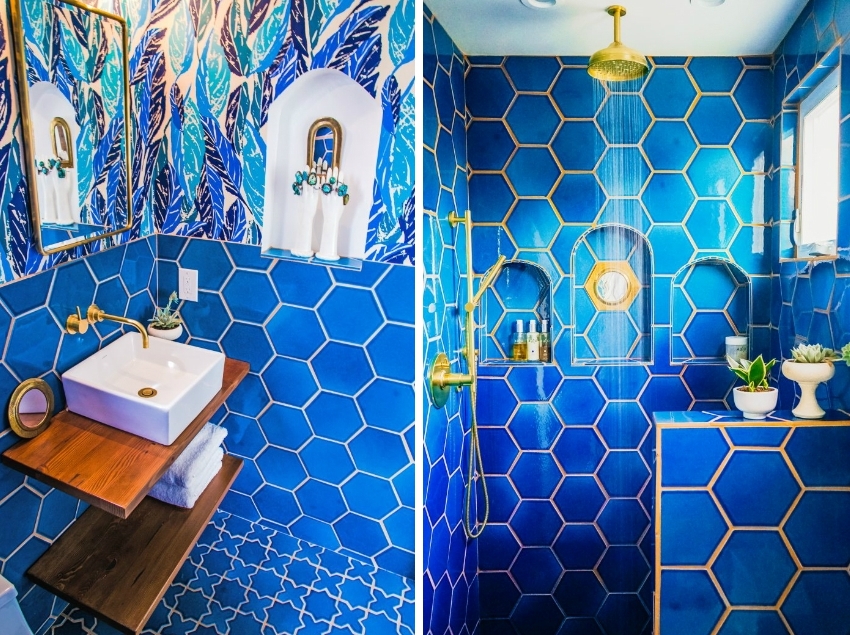
Thanks to a wide selection of shades and shapes of ceramic tiles, the bathroom interior can be decorated in any of the style directions
In the decoration of bathrooms, the photo is a clear confirmation of this, with an area of more than 2 m², a combination of colors is appropriate. Shades such as pink and lavender, blue and blue, cream and chocolate go well with each other.Also, you can play on the contrast of the colors of blue and yellow, white and red, yellow and purple. You can dilute solid colors with decorative ornamental inserts, harmoniously matched to the main palette.
Useful advice!When the preference is given to using tiles of three or more colors, it is better to choose a mosaic, where even the variegated shades of a small tile cannot visually reduce the room.
Looks unusual and original bathroom design tiles on a purple base with splashes of yellow. Plain walls can be complemented by panels of different colors or tiles with a pattern at the bottom and top.
You can create a warm and cozy atmosphere by applying beautiful tiles to the bathroom in soothing colors: yellow, green, blue, light pink, peach, beige and terracotta. Their shades can be safely combined with each other. In order for the room to radiate light and give positive emotions, it can be decorated in pearl, cream, lavender, sky blue or silver.
Important!For the design of the room to be harmonious, the floor tiles should have a darker shade, which must be present as small blotches on the walls of the room.
Color palette for small bathrooms
For a small room, choose a tile of light shades. It is better to refuse products of red, black, brown, lilac, dark blue as the main color. They will make the room even smaller.
The ideal option is the use of white glossy tiles, which make the room fresh and airy. However, in order not to turn the room into a kind of hospital ward, the interior can be diluted with bright decorative elements. This could be a foot mat, lighting fixture, or towels.
White marble tiles are very popular for small bathrooms, which can not only visually enlarge the premises, but also give it a slight touch of sophistication. With such tiles, photos of bathrooms are a clear confirmation of this, the room will look stylish and expensive.
A good modern option for a small room is to decorate bathrooms with tiles, the photos clearly reflect this, in various shades of gray, which is the ideal basis for white sanitary ware and shiny accessories. You can create an atmosphere of weightlessness by decorating the bathroom with tiles, a photo confirmation of this, natural blue or blue.

In order for the interior of the bathroom to be harmonious, the shades of tiles and other finishes must be combined in accordance with the color scheme
You can also use dark tones for contrast here. However, they should appear in edging, large patterns on a wall surface, or in ornamental flooring. For those who want to get away from the light palette in the design of the bathroom, you can combine colors, one of which must be necessarily white. For the second option, you can choose any bright and saturated color, with the help of which an accent wall or a whole sector in the bathroom is created. This can be an apron over the sink, the floor or the shower area.
Size range of bathroom tiles
Bathroom tiles are classified by product size:
- large tiles with dimensions of 250x400 mm;
- medium-sized tiles 200x200 to 300x300 mm;
- small tiles 60x60 to 200x200 mm in size;
- mosaic tiles ranging in size from 10x10 to 50x50 mm.
The large category includes products in sizes: 250x1250, 400x400, 300x450, 250x500, 200x400, 300x600, 310x500, 400x600, 600x600, 400x800 mm, the installation of which is carried out faster than other types. However, the size of the room should also be taken into account so that the amount of waste is minimal. The largest tile is most commonly used for flooring. Such dimensions have porcelain stoneware that can withstand the greatest loads.
Products that belong to the middle category can have a size of 100x200, 150x250, 200x250, 250x250, 300x300 mm. These tiles can be used for spacious bathrooms. This can be clearly seen in the photo on the Internet, where the main role is assigned to the white tiles 30-30 cm.
Small tiles have several standard sizes: 60x60, 100x100, 130x130, 150x150, 200x200 mm. It is advisable to use such products for small bathrooms, with the help of which the room will appear visually wider. Large products will load the room and look bulky.
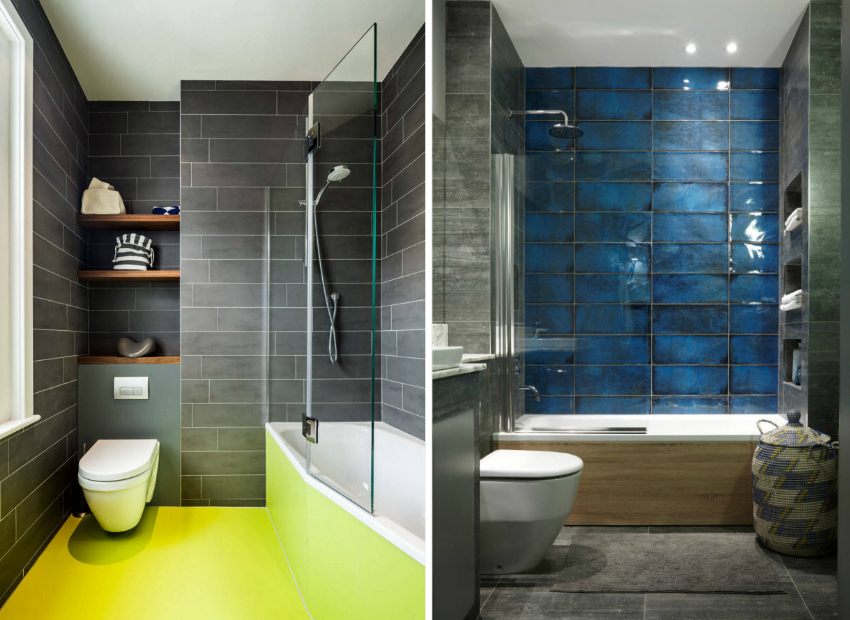
The size of the tiles must be chosen based on the size of the bathroom in order to avoid ugly joints and a large number of scraps.
Mosaic tiles are ideal for combining with large items. It can be used to fill rounded surfaces and difficult hard-to-reach areas such as arches and niches. It is the ideal solution for edging. It is often used for facing an apron or as an ornament.
Useful advice!Do not use mosaic tiles as a complete bathroom wall cladding. This will lead to the formation of many joints between the tiles that require special care. This technique is advisable if the walls of the room are rounded.
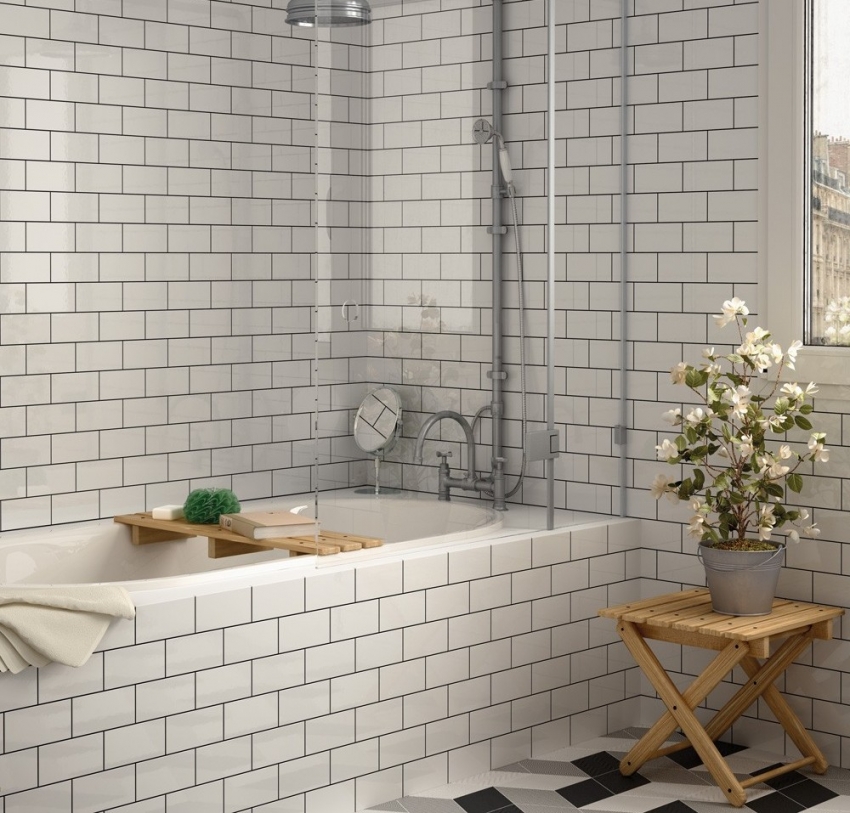
Installing medium-sized white tiles around the entire perimeter of the walls will help visually expand the bathroom space
What is ceramic tiles in the bathroom?
Most often, tiles are used to decorate bathroom walls. For this, there is a huge assortment of products of various colors and shades, textures and sizes. To give the surface a unique look, you can combine tiles with various borders, inserts, friezes, panels and other decorative products.
The flooring is a non-slip bathtub tile that is larger than wall cladding. It is a reliable, moisture resistant and durable coating that will complement the chosen design of the room decoration.
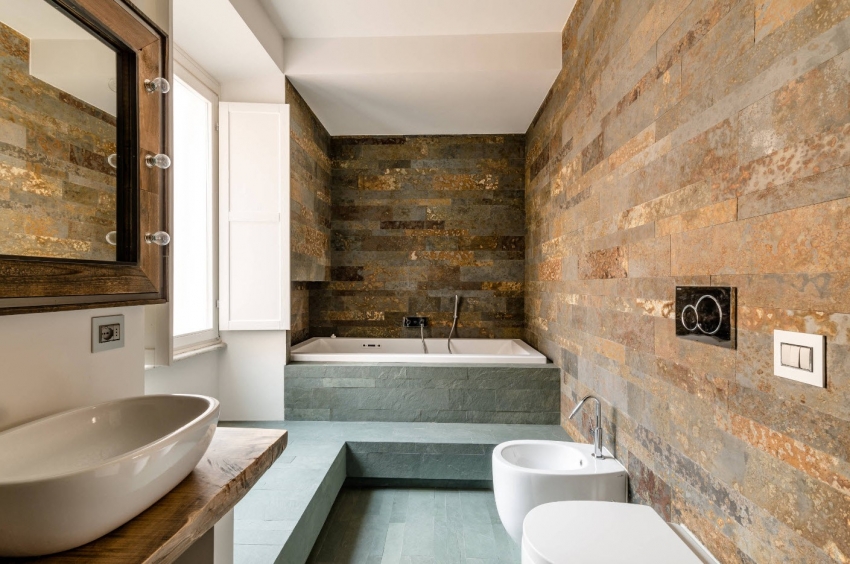
Sometimes, for the embodiment of design ideas, floor tiles are used for the walls, but with this option, a high-quality base and adhesive are needed
To decorate the ceiling, tiles are rarely used. This is due to the increased complexity of the preparatory and installation work. However, as a result, you can create a modern, stylish, perfect and original appearance of the room. For ceilings, the most appropriate option is to use extruded tiles with a smooth surface, which are available on the market in a wide variety of shades and sizes.
In modern bathrooms, you can increasingly find a countertop, with the help of which it is possible not only to increase the usable area in the room, but also to improve its functionality, and give the bathroom a respectable look. The table top is created from plasterboard, and then finished with mosaics, tiles or porcelain stoneware.
Useful advice!In order for the bathroom to have a harmonious appearance, the wall cladding and countertops must be made of the same material.
The niche under the bathroom can also be closed with plasterboard, which is tiled with tiles. It is also used for wall decoration.

Mosaic tile often used to decorate niches and arches
Bathroom tiling options. Photo examples
Before you start finishing the room, you should decide on the option for laying tiles, which depends on the chosen design of the room. Tiling the bathroom, photos clearly show this, can be made according to the shape or color of the products.
In the classic version of the bathroom finish, tiles of a light shade are laid at the top, and the bottom of the room is decorated with products of a darker shade. Here you do not need to come up with a layout of products and calculate the required amount of material. Harmonious color combinations are already presented in bathroom tile catalogs. However, such masonry visually reduces the room. Therefore, it is recommended here to create a clear border between the colors using a vertical frieze, thanks to which it will be possible to expand the space.
The shape of the tiles can be square or rectangular. The first option is more often used for flooring, and the second for wall cladding. Rectangular products can have a horizontal layout, thanks to which you can visually expand the premises. Vertical tiling allows for increased room height, ideal for bathrooms with false ceilings.
Various combinations of horizontal and vertical masonry look unusual and unique. Here you can also highlight contrasting areas with brighter tiles.
Tiling options in the bathroom
Bathroom tiles can be installed in one of the following ways:
- basic;
- at random;
- diagonal;
- chess;
- modular;
- ornamental.
The most common and simplest is to lay the tiles in the bathroom seam in a seam in even rows, parallel to the corners and walls. The seams between the slabs resemble straight lines, the horizontalness of which is checked with a square, and the verticality - with a plumb line. This traditional method is the most economical, where the minimum amount of waste is generated with the correct selection of product sizes.
Useful advice!It is not recommended to lay tile without seams in this way, since the products have slight differences and will create an inaccurate appearance of the finish.
Spreading of tiles is performed in horizontal rows, where the products of each subsequent row are shifted relative to the previous one by ½ part of the tile. For laying tiles with an offset, rectangular products are used, which can have horizontal or vertical laying. This method allows you to hide the flaws of uncalibrated tiles.
Useful advice!If this option is used for laying flooring, you should not combine products of two colors or different textures. The floor will visually appear uneven.
The most time consuming and difficult is the diagonal tiling, which requires professionalism and skill. It allows you to visually expand the room, to hide the non-parallelism or non-perpendicularity of the walls. Diagonal laying of tiles, the photo clearly confirms this, also allows you to create an original and beautiful pattern on the surface of the walls.
Important!The use of a frieze or other clear accent is inappropriate here.
The most important steps in this finishing method are the correct marking and laying of the first diagonal, which will become the starting point for further work. Tile joints are located to the wall at an angle of 45 degrees, and must be strictly perpendicular to each other. This is checked using a square and a level.
Even slight deviations in the dimensions of the products, which may lead to a distortion of the pattern, should not be allowed here. It is also worth considering that this method involves a large amount of waste.
Two-tone combinations of bathroom tiles. Photo examples
The most popular option when using solid tiles in two different colors is checkerboard masonry. A kind of checkerboard is created on the surface of the walls or floor. The tile is laid seam in seam or diagonally. Such a drawing will certainly refresh the interior of the room. White and black bathroom tiles will look interesting in this interpretation.

In the collections of different tile manufacturers, you can find matte, translucent, transparent or with decorative splashes of mosaics
The modular method of installation is more complex, but at the same time an interesting option that requires great care from the master. The tiles are selected with the same shape, texture, but different sizes. Here it is important to choose at least three standard sizes, in which the sides will be multiples of each other.
Useful advice!For a modular version of the masonry, preference should be given to products labeled "modulare", in which strict compliance with all sizes is observed.
According to this option, the tiles in the bathroom, the photos confirm this, can be laid in a different order, which allows you to create an interesting pattern that favorably emphasizes the geometry of the space. Products can be placed randomly or be sustained in a certain pattern. Here you can safely use tiles in contrasting colors, which should be in harmony with the overall design of the room.
The ornamental method involves creating a certain pattern on the floor or on one of the accent walls in the form of a carpet, which is additionally decorated with panels at the edges, or a plain canvas with a bright pattern in the center.
There is also a combined bathroom tiling. Photos of design options show the simultaneous use of several methods. However, here you should clearly think over the design of the room in order to exclude the appearance of individual inappropriate fragments. One of the most popular options is a mosaic or tile panel, which you can lay out yourself or buy ready-made.
Combined bathroom finish: tiles in combination with other materials
When creating a bath design, tiles can be combined with other cladding materials. The easiest, fastest, cheapest and most practical way to transform a room is to paint the walls. In this case, the tiles can be laid 1/3 or 1/2 of the wall from the floor. Further, the surface to the ceiling is painted with paint. Often the tiled wall covering turns into the floor covering, which looks complete and harmonious.
No less worthy, but not so practical, is the combination of tiles with wallpaper. However, this option has a right to exist. You can tile the surface of the walls around the bathtub or in the shower stall, and glue moisture-resistant ones on the rest wallpaper, which can be additionally coated with a special water-repellent compound. Themed collages, photo wallpaper or panels, stylistically correctly selected for the design of the room, will look very interesting and unusual.

To decorate a bathroom in a classic style, you can use moisture resistant wallpaper
In the decoration of the bath, the photos of the options display interesting techniques, you can profitably use a combination of tiles and PVC panels that imitate tiles. Such a variation will allow using panels to hide the places of passage of plumbing communications, at the same time providing unhindered access to them if necessary. In addition, this material is much cheaper than tiles, which will save money when decorating a bathroom, but not lose in practicality and aesthetics.
Adherents of natural, environmentally friendly materials will like the combination of tiles with wood panels, which are treated with a special varnish that prevents moisture from penetrating into the cavity of the product. The combination of panels with 20x30 cm glossy white tiles, which favorably set off the noble look of wood, will help create a cozy and warm atmosphere. Another variation that deserves attention is the combination of material with porcelain stoneware tiles. Such a bathroom will look stylish, expensive and presentable.
A relatively new design trend is the cladding of the bathroom with decorative plaster, which allows you to hide imperfections in the wall surface. This finish is ideally combined with tiles that can only cover the bathroom area, or make accent inserts on all walls of the room. Decorative plaster can be coated with acrylic or mother-of-pearl varnish, which will allow the room to glow from the inside in bright light.
Bathroom design: photo of tiling rooms made in different styles
Modern design offers several styles in which you can decorate a bathroom. On specialized sites on the network, there are many different photos of bathrooms tiled with tiles. You can choose the option you like the most and bring it to life. Also, today there is an opportunity to use the online bathroom design service, which will allow not only to calculate the required number of tiles, but also to see the profitable layout options.
For adherents of natural materials, the design of a room made in eco-style... Here, it is advisable to use tiles in the bath, made in a natural color palette, which can be combined with bamboo wallpaper or wood panels. Also, the wall cladding with porcelain stoneware will look appropriate and natural.
The Loft style is very popular, where tiles that imitate brickwork are used. An interesting design solution for this trend is the cladding of the bathroom walls with white hog tiles in combination with a dark porcelain stoneware floor.
High-tech style involves the maximum use of modern materials, technologies and communications. The use of plastic, metal and glass prevails here. For the decoration of bathrooms, gray, black, silver and white glossy tiles 10x20, 15x25 and 20x30 cm are often used, which favorably set off decorative elements in the form of beams, pipes and exposed supports.
The black and white bathroom tiles reflect the requirements of the minimalism style most successfully, which, thanks to the color contrast, creates a comfortable and at the same time restrained design of the room.
The Scandinavian style, which is defined as cozy minimalism, is characterized by pastel light colors in the design of the room. She is able to fill the room with air and freshness.The ideal option for the embodiment of this style is the use of white tiles in the bathroom, the photo clearly confirms this, together with bright accents in the form of colored compositions on the walls, a laundry basket or towels. It works well with dark natural stone flooring.
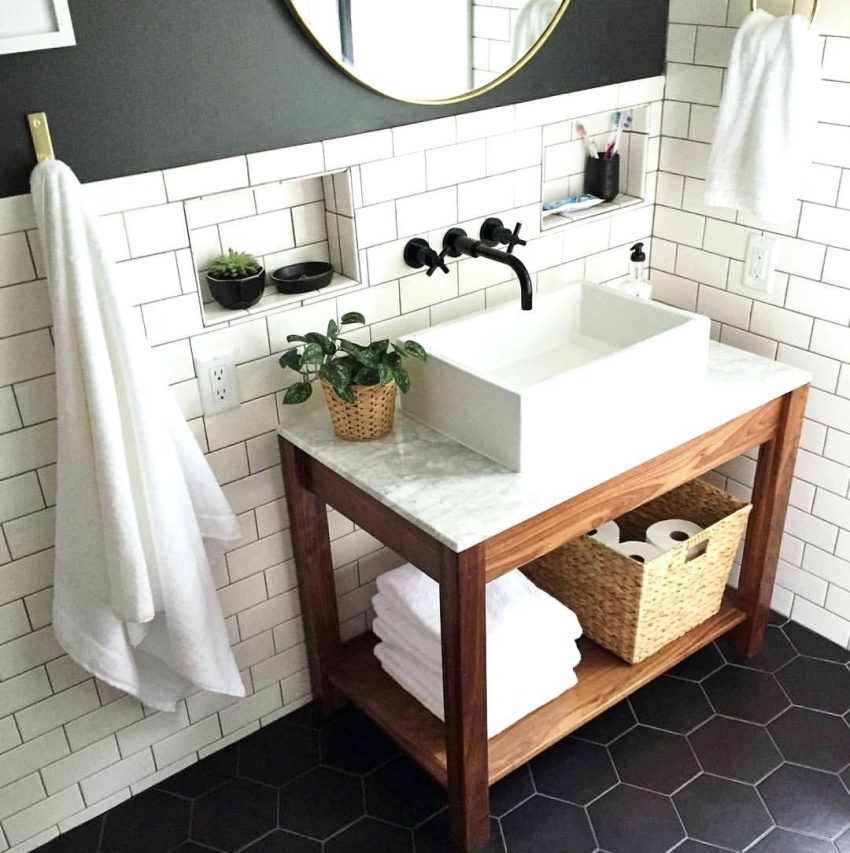
Black and white tiles are often used for decoration Scandinavian interior
You can create a cozy room with a simple design in the Provence style, which is characterized by a warm calm color palette and natural materials. Milk, blue, lilac and beige tiles will look most successful in the design of the bathroom, which can be shaded with floor tiles of a darker shade.
Bathroom tile technology
Bathroom tiling consists of several stages:
- Preparation of the base.
- Laying tiles.
- Grouting.
To complete the entire list of work, you will need the following materials and tools:
- primer mixture and self-leveling mixture;
- tile;
- adhesive and a bucket for preparing the working solution;
- grout, sealant;
- trowel, usually aluminum;
- spatulas: straight, notched, rubber;
- wooden slats and building level;
- square, plumb;
- roulette;
- tile cutter;
- crosses;
- marker;
- rags.
Any installation work begins with surface preparation. The further period of service of the facing coating will depend on its condition. You can also consider laying tiles on tiles if the coating is of good quality. If there are doubts about the reliability and quality of the previous layer, it is necessary to remove the old coating. To do this, you can use a hammer drill with a special attachment. The wall surface should be cleaned of signs of putty and paint. If significant dents or cracks appear, they should be repaired with putty.
The base must be thoroughly cleaned from dust and various stains. Next, the surface is treated with a primer mixture. Using a level, it is recommended to check the evenness of the walls in order to have an idea of the thickness of the future layer of the adhesive mixture.
Useful advice! If the base is painted, for better adhesion, several notches must be made over the entire wall area.
After removing the old floor covering, tap the surface. If a dull sound is heard, cavities have formed under the old screed, which will lead to a fragile base. It is recommended to dismantle the old screed and make a new one using a cement-sand mortar. After the screed has completely dried, the surface is primed and dried.
Further, with the help of bituminous pastes or a special composition, waterproofing is arranged, which, after drying, is primed. To eliminate unevenness of the base more than 5 mm, you can use a self-leveling mixture.
Useful advice!Qualitatively performed preparatory work will help speed up and simplify the installation of tiles and save adhesive composition.
Selection of related materials for laying tiles
Choosing a good tile is not enough to create a durable cladding. An important measure is the purchase of high-quality glue, waterproofing material and grout for joints.
It is better to choose glue on a cement basis, which is easy to apply, is not afraid of moisture and provides good adhesion of the tile and base. The most popular are the following compositions: Yunis Plus, Ceresit CM 11, Weber vetonit ultra fix.These adhesive mixtures are designed for ceramic tiles and porcelain stoneware for indoor and outdoor use. They can be used for any reason.
Waterproofing in the bathroom can be done with a coating or pasting material. For the floor in large rooms, it is more advisable to use roll material. And for small rooms and walls, it is more convenient to use a coating composition. The most popular are mixtures: Perfekta Aqua Stop, Ceresit CR-65, Panetron, Knauf Flachendight.
Choose a cement or epoxy grout. The first option is easier to use and cheaper than analogues. The second composition creates a stronger and more durable coating, however, it is more difficult to work with it and its cost is much higher than that of a cement material.
Bathroom waterproofing
Waterproofing is an important step in bathroom renovation. It helps to increase the service life of the decoration of the room, reduces the likelihood of mold and mildew formation, prevents damage to the concrete surface of the base and reduces the risk of flooding of neighbors.
The waterproofing layer is carried out over the entire floor area with a minimum 20-25 cm approach to the wall. Also, the creation of waterproofing is necessary at the places where plumbing fixtures are installed.
Waterproofing can be glued, in the form of a roll and coated, in the form of a thick paste. The first type of product usually has an adhesive base. To mount it, cut a piece of material of the required length. Further, the protective layer is removed from the back of the product, and the material is tightly glued to the base. If roofing material is used, it is fixed with glue mastic or special glue.
It is recommended to lay the second piece of material with an overlap of 4-5 cm. In this case, the seams should be treated with a sealant. The waterproofing layer must extend onto walls at least 15 cm high from the floor. Next, a concrete screed of the base is performed.
The application of the coating waterproofing is carried out with a brush or roller. The layer is applied with a thickness of no more than 1 mm when using liquid filling, and 3 mm in case of using paste. Work should be done carefully and carefully to prevent the formation of gaps.
If bituminous mastic is used, a concrete screed must be applied over the layer. In the case of using a cement-polymer mortar, which simultaneously provides lifting and leveling the floor, the screed is not required.
When waterproofing walls, it is advisable to use a coating compound. Particular attention should be paid to the corners and points of entry and the location of pipes. After the waterproofing layer has completely dried, the surface is covered with concrete contact for better adhesion of the base and tile adhesive.
Bathroom wall tiling
Tiling a bathroom begins with wall cladding. You can do the work yourself or contact an experienced craftsman for help. The cost of services will depend on the selected type of material and masonry option. So, the average price per m2 of laying tiles in the bathroom is 600 rubles.
On the prepared surface, using a level and a measuring cord, a line parallel to the floor is applied at a distance that is equal to the height of one product and the thickness of the seam. Wooden slats are installed along the resulting line, from which the tiles will be laid.Installation starts from the wall opposite the front door.
Next, you should lay out the first row. If the last product needs to be cut, then the wall surface is divided in half and a central line is drawn from which the laying will be carried out. This will create a symmetrical bathroom finish.
A working solution is prepared using a construction mixer, which is stirred at low speeds for 2-3 minutes to eliminate the formation of bubbles. This can further lead to weakening of the adhesive layer and its shrinkage.
The adhesive is applied to the surface with a flat trowel. Then it is leveled with a toothed tool so that horizontal furrows are formed. The mortar is also applied to the pre-wetted back of the tile.

It is better to start installation of tiles from a corner, but it is worth considering the method of laying and the shape of the tiles.
The first tile is installed in the corner formed by the horizontal strip and the vertical line. Subsequent tiles are laid based on the chosen laying method. To create even seams, crosses are used, which are inserted between adjacent tiles. Three or four rows are stacked at a time. The evenness of the masonry is periodically checked by the building level.
Useful advice!The larger the tile size, the thicker the tile joint can be made. However, the wider it is, the closer the room becomes.
After laying the whole products, they proceed to the installation of edging elements. The bottom row is laid in the very last place after removing the horizontal bar. The crosses must be removed before the glue dries completely.
If the bathroom configuration has external corners, they should be tiled exclusively with whole tiles for the best visual effect. To protect the corners, special corners or plastic corner profiles are used, which are installed under the tiles.
Wall tiles can also be laid from the bathroom level. The first row is mounted along the side, stepping back 2 mm to form a seam. After laying the tiles along the entire height, they begin to finish the area below the bathroom level. This option will create the most harmonious look, which will eliminate the formation of a narrow strip of tiles above the bath rim.
Features of the process of laying tiles on the floor
After the tile laying option has been chosen, you can proceed directly to its installation. It is necessary to start work with parallel laying from the far wall towards the doors. The diagonal method assumes installation from the center of the bathroom in order to obtain a symmetrical gap.
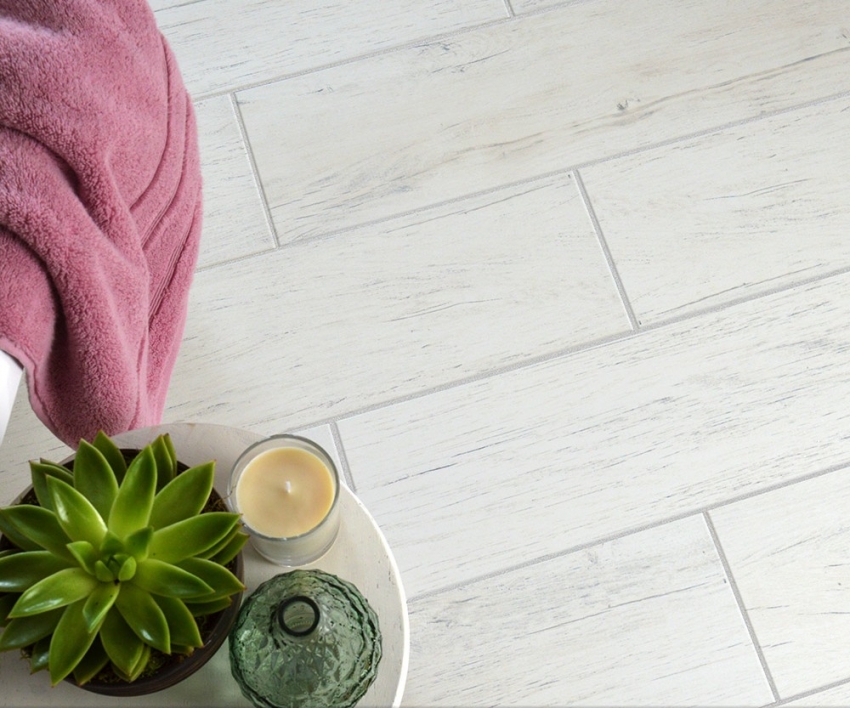
In order for the seams of the floor tiles to have an attractive appearance, they must be disinfected from time to time
Also, you should immediately determine the installation location of the bathroom or shower stall, washing machine and furniture, under which you can hide tiles with cut edges. Installation is carried out from an open corner, where the whole tile will be located, to the wall with plumbing, where the cut products will be hidden.

For quality installation of bathroom tiles. it is necessary to study the technology and advice of specialists
The speed and ease of work directly depends on the correct location of the first tile. To do this, it is necessary to carry out the correct marking taking into account the thickness of the seams. The material is pre-laid on the floor. So, it will be possible to choose the most optimal placement of the tiles and make sure that it fits tightly to the corners.If there is a space in the row that is not filled with solid tiles, it is recommended to move the products so as to create the same distance on both sides. This will provide a more aesthetic masonry. The outermost tile is outlined with a pencil. It is along this contour that the laying of products begins with the traditional installation of products seam in seam.
The next tile is stacked next to the first in the same way. An even distance between products can be obtained using plastic crosses inserted at the corners of the tiles. The tile is pressed and aligned horizontally. In this way, all solid tiles are laid. Only after that do they start installing edged products. To do this, the tile is applied to an empty area of the floor and a cut line is drawn. With the help of a tile cutter, an extra fragment is removed.
Useful advice! If the edged tiles are hidden behind furniture or a bathroom, you do not need to move a row of products, but start laying from the far open corner of the room.
The ready-made mortar is applied to the floor in a thick layer using a spatula equal to the size of one tile. Next, the composition is leveled over the surface with a notched trowel to form parallel grooves. Then a layer of adhesive is applied to the back of the pre-moistened first tile using a notched trowel. The tile is firmly pressed to the base. The evenness of the masonry is checked by the building level.
Useful advice! On the back of the tile there is an arrow that indicates the direction of the laying. To avoid distortion of the pattern, make sure that the arrow always points in one direction. This is especially important when using woodgrain bathroom tiles.
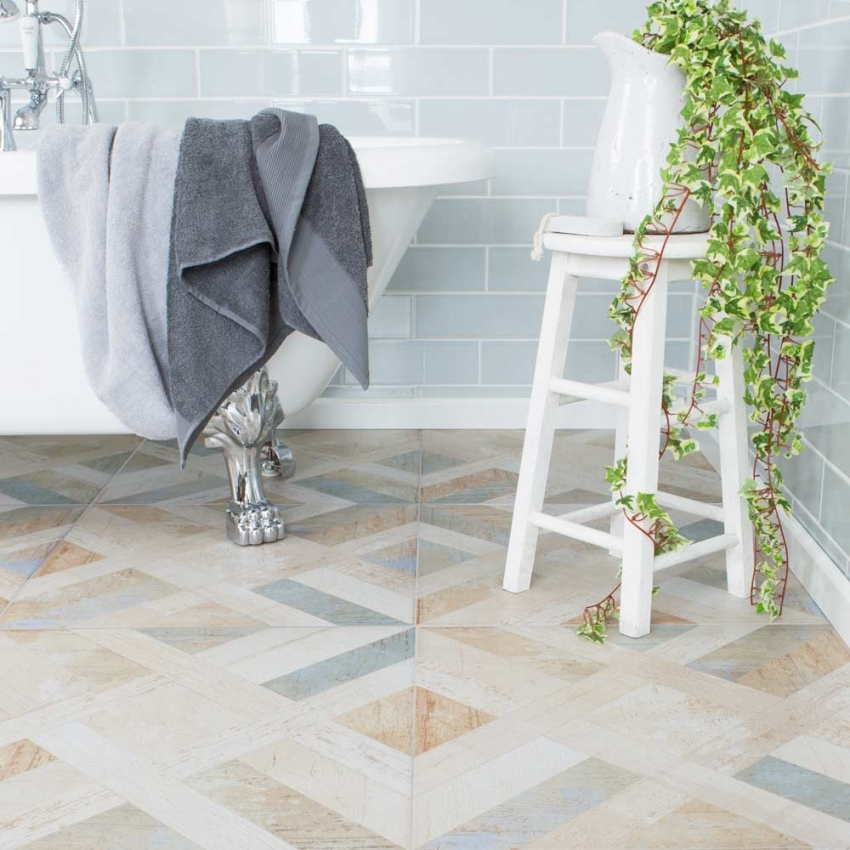
In order for the surface of the coating to be even, the laying should be checked using a building level.
Options and features of jointing seams
The final stage of finishing the bath with tiles is the grouting of the tile joints. This event is held in 2-3 days. Before grouting, remove excess glue from the inter-tile space. A special mixture is used as a grout, from which a working solution of the desired consistency is prepared. The cement-based compound is suitable for any gap thickness. The use of an epoxy compound is suitable for thin joints.
To apply the grout, a rubber-based spatula is used, with the help of which the inter-tile space is filled with a grout, carefully rubbing the composition into the grooves along the entire length of the joint. The fugue should be flush with the tiles. Excess material is removed 10 minutes after application. After the solution has completely dried, you will have to make an effort to wipe it off.
All butt joints of tiles with sanitary ware are also treated with grout. After the mortar has completely dried, the tiles are wiped off with a damp cloth, which must be rinsed frequently so that no white stains remain on the cladding.
Useful advice!For a more reliable waterproofing of joints, after 10-14 days, you can cover the joints with a waterproof compound.
The color of the grout should be in harmony with the main shade of the tile. The more contrasting the color of the seams, the more clearly the flaws of the finish will be visible on the surface of the cladding. In addition, it visually narrows the overall space in the room. You can visually expand the spaciousness of the room and create a single space with the help of a fugue matched to the color of the tiles.
If the seams on the floor are too light in color, they can quickly darken, which will require constant timely maintenance. On gaps that are too dark in color, dust and water marks will be clearly visible.
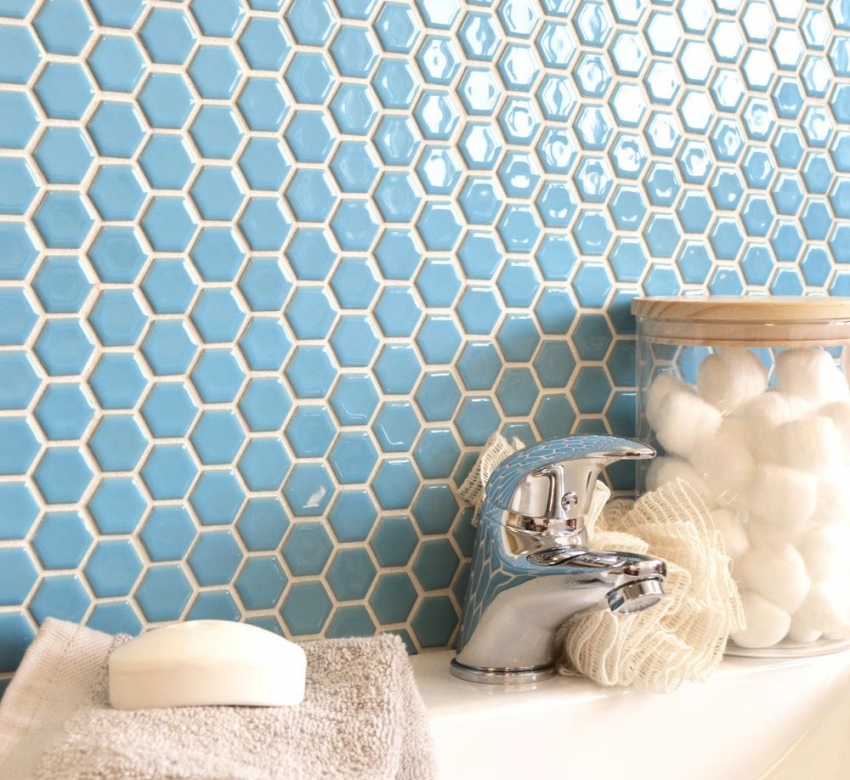
When grouting joints, it is important to choose the correct composition of the fugue so as not to damage the glossy surface of the tile.
Review of renowned bathroom tile manufacturers
Before you buy tiles for the bathroom, you need to familiarize yourself with the range of products that are presented on the construction market by different companies. Each manufacturer strives to produce quality products designed for any budget and request.
Kerama Marazzi is one of the largest domestic companies for the production of ceramic tiles and porcelain stoneware. Products are manufactured on Italian equipment with the involvement of foreign specialists. The result is a high-quality material with a unique design, which is not inferior in its properties to the Italian counterpart. All products are grouped by collections, which are clearly displayed in the Kerama Marazzi catalog. The price of tiles varies between 600-1750 rubles / m², depending on the type of product.
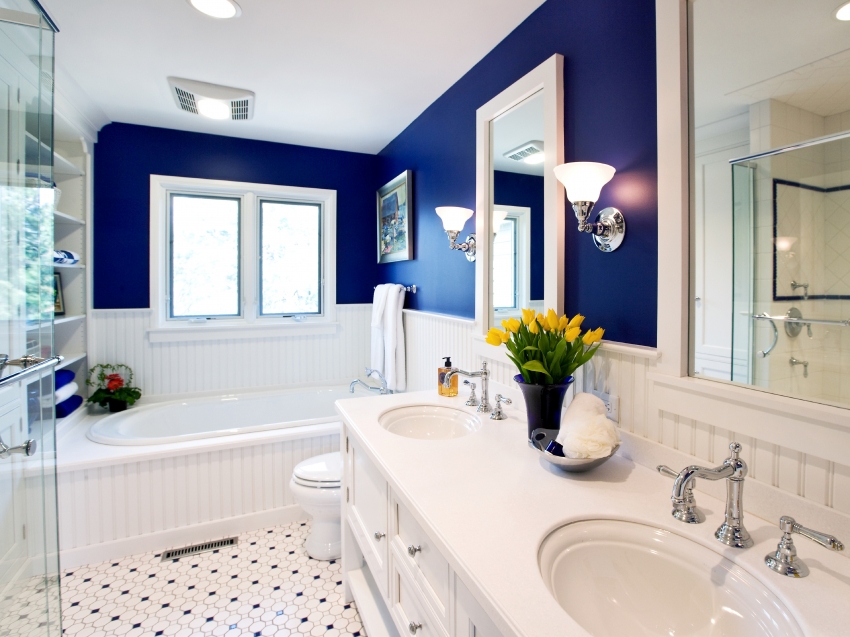
In order to get a high-quality and durable coating, it is better to purchase tiles from well-known manufacturers.
The Unitile group of companies ranks among the best ceramic tile factories. Here, using high quality raw materials, double firing technology, innovative Italian equipment and exclusive dyeing technology. a unique product is obtained, which is famous for its high quality, durability and a variety of colors and textures. The cost of the material is 350-700 rubles / m².
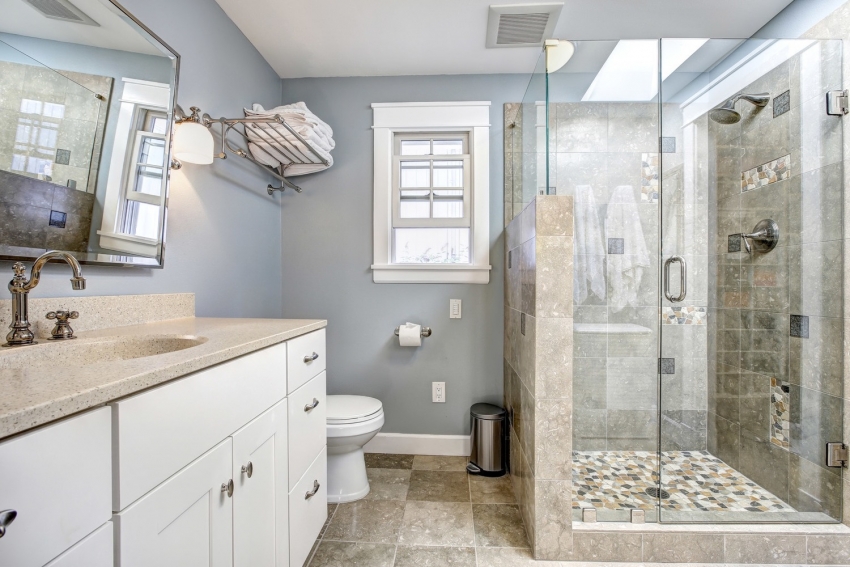
The ceramic tile manufacturer Azori is distinguished by a wide range of products with exclusive and original designs.
Azori company produces a wide range of ceramic products with exclusive and original designs. All newfangled world tendencies are boldly brought to life here. The quality of the products is not inferior to the best Italian counterparts. You can buy bathroom tiles for an average of 400-550 rubles / m².
The products of the world brand Italon are distinguished by high quality, simplicity, restrained sophistication, originality and a huge assortment, which is adapted to the domestic market. The cost of tiles is on average 300-600 rubles / m².
Estima specializes in the production of porcelain stoneware and ceramic tiles. Each collection is thought out to the smallest detail, and thanks to the latest technology and modern equipment, it meets high quality standards. Cost per sq. m. tiles are in the range from 300 to 500 rubles.

Corner bath takes up less space in the bathroom and saves space
Popular collections of bathroom tiles. Photo examples
There are many collections of bathroom tile designs on the construction market. Here you can find monochromatic products in various colors, tiles with imitation marble, stone, wood. Collections with luxurious plant motifs are very popular.

You can add expressiveness to the bathroom with the help of bright decorative elements or inserts of contrasting tiles.
The white tiles in the bathroom take pride of place. Photos of rooms decorated using this material emphasize the airiness, freshness and lightness of the room. You can add expressiveness with the help of bright decorative elements or the use of accent inserts when lining the bathroom.
To create a semblance of marble slabs in the interior decoration, you can use white 20x30 cm tiles from the Carrara collection, which is offered by the Italian manufacturer Venis. Another interpretation of marble can be seen in the Aqatha collection from Spanish manufacturer Peronda, which features warm chocolate and creamy tones on the tiles.The mesmerizing series I Marmi from La Faenza represents a semblance of onyx, the surface of which accurately conveys the natural structure of natural stone.
Designers of world brands are constantly experimenting to create products that embody the original imitation of natural wood. This is most strikingly reflected in the Unicom Starker Timeless, Vintage by Settecento and Bergen by Venus.
Those who want to create a real flower paradise in the bathroom will love the Linda, Toscana, Provance collections from the manufacturer Almera Ceramica and Purity, Groove, Ritmo from the APE company.
A wide variety of bathroom tiles and a variety of installation options allow you to create an interesting and unusual room design. The main thing when choosing a material is to be guided by the size of the room, taking into account which the size, color and option of laying the tiles are selected.
